Posts Tagged ‘prescribed burning’
Monday, July 18th, 2011
The duty of fire fighting is to detect, control and suppress fires..
If bushfire fighting cannot do this reliably outside the urban environment, then the bushfire fighting promise has become a community lie and a deadly one at that..
This is a duty, irrespective of who is charged with the responsibility – government professionals, local volunteers, outsourced contractors, whomever?
But people in the bush are dying in their homes and in their cars, irreplaceable property has gone forever, and vast valleys and ridges of Australia’s rare ecosystems are being incinerated into extinction.
Australia’s post-war Dad’s Army model has long become ineffective. It has become a reckless and incompetent menace luring vulnerable bush communities into a false sense of security and trust, to their death..
It is long time that Australia’s post-1939 Black Friday bushfire fighting mentality, resourcing and infrastructure were challenged by communities!
.
The following is article was initially posted by Tigerquoll 20090326 on CanDoBetter.net:
.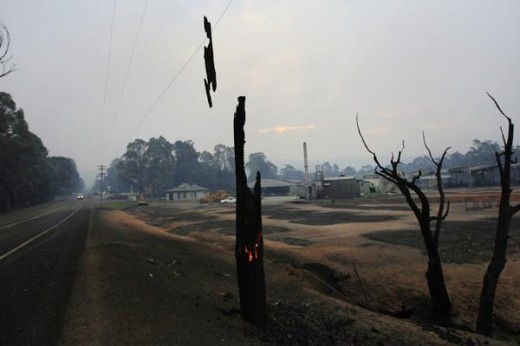
Out of the media frenzy to get ratings out of the Victorian bushfires, a ‘so-called’ bushfire expert on an ABC 730 Report panel (David Packham) advocated a 6 to 7 fold increase in prescribed burning for Victoria.
Another neo-Dreamtime wizard?
The effectiveness of this strategy is undermined by the live evidence shown (on ABC 730 Report Thursday 12-Feb-09) of local resident Jim Baruta in his home video. Over 200m of clear paddock stood between the bush and his house. This represents hazard reduction to an extreme degree (no trees or undergrowth for 200 m). Yet it was ineffective defence. Only his bunker saved his life.
As the ‘heat’ of the tragedy cools down, one of the overlooked impacts that needs to be considered in a balanced way is the impacts of broad scale fire (prescribed, wild, arson or otherwise) is having on the habitat of ground dwelling mammals. In the search for answers to avoid a repetition of the firestorm it is important that natural areas of high conservation value including old growth forests receive due recognition as natural assets worth protecting. Its integrity is not being measured and is probably disappearing through fire at a rate comparable to what logging is causing in SE Asia. That the bush grows back is not an indicator of its biodiversity health.
One must recognise that the bush (habitat) is also the innocent victim of these horrific fires. Dense ground cover is a fuel for fire but also home for wildlife. Keep removing the fuel and one removes the wildlife- eventually to its mass extinction. The underlying causes of the fires are the ignition, the lack of non-burnable material to create a buffer between good bush and human settlement, the slow detection of ignitions, the slow response to these while still manageable (remote country or otherwise) and the inadequate resources to suppress many spot fires. As to the ignition cause being arson – Australia needs a serious permanent criminology unit dedicated to this crime. The media and our leaders need to be careful not to incite dormant serial arsonists – just like one read and watched in the days preceding the first arson attack at Delburn on 29 Jan. The media frenzy just fuelled the copy cats’ excitement.
Bushfire management is a complex issue, so poorly under resourced, so poorly disconnected from bushfire research, yet so integrated into the lives of so many Australians. The public deserve a say into the Royal Commission. Those who tragically died and lost everything deserve billions not just in recovery but in the whole task of bushfire management.
.
.
Comments:
.
Re: Prescribed burning
April 17th, 2009 by ‘Matthew’:
.
I don’t doubt your commitment to the environment, but you’ve got it exactly backwards. Increased burning is exactly what we need. Not just for human safety, but because the Australian ecology depends on fire at the very least as a means of recycling dead matter (The Australian ecology is different from many others in that our lack of water tends to inhibit microbial decomposition – as a result fire takes on that role).
There are many other reasons, as well. The natural adaptation of Australian plants to fire means that fire suppression actually helps drive native species to extinction, as they are out-competed by faster growing, more prolific seed spreading imported weeds. This is often accompanied by native animals being pushed out in the same fashion.
But the weeds, by putting their effort into spreading widely, have few resources left to recover from periodic annihilation events (like bushfires), meaning that where the bush burns periodically, native plants and wildlife have a natural advantage. Strange as it may sound, continual fire protects native species.
So long as the fires are not the huge events that just happened, of course. Continual small fires (such as aboriginals lit – look up “firestick farming”) has proven to be best. This is not to say that exactly the same areas should be burned each time, of course.
An early paper of Tim Flannery’s on the subject would be a good introduction to the historical importance of fire, and how it relates to the rest of the Australian environment – please don’t be put off by the windy title: “The Timing, Nature, and Aftershock of Pleistocene Extinctions in Australia” (^http://www.amnh.org/science/biodiversity/extinction/Day2/bytes/FlanneryPres.html)
.
.
Lies, damn lies, and bushphobic myths
April 19th, 2009 by Tigerquoll:
.
Burning native habitat is State-sanctioned arson. If not, then perhaps Matthew in his claims above can offer verifiable ecological authority behind the myths he relies upon to justify why deliberatly setting fire to native habitat is ‘good’ for it?
.
Myth 1: “Increased burning is exactly what we need.”
Arsonist profess this, so how do you differentiate yourself? Arsonists feel good about lighting fires.
.
Myth 2: Bushfire is “good for human safety.”
Ambit claims deserve no more than single words rebuffs like: ‘crap’. But politely, I offer a more reasoned response.
Many prescribed burns actually get out of control and become the threat to human safety they are trying to avoid. Human safety is about not building in bushfire prone areas and not using materials that burn. Why is this logical solution avoided? If you choose to build in the bush and then burn the bush so that there is no bush around to burn, have you ust defeated your purpose of building in the bush? Bushfires burn down houses mainly fronm ember attack which can travel by winds many kilometres, so to remove the threat of ember attack, how many kilometres circumference of bush do you need to destroy to feel safe – 3km, 10km? You may as well build you house on farm land with no trees, undergrowth or grass in sight. Then you may be safe from ember attack. Think of the St Andrews example during the February Victorian Bushfires.
Bushfire fighting is all about rapid detecton, response and suppression of ignitions. Currently most bushfires are detected by thoughtful members of the public calling 000, then volunteers are called in and drive out in fire trucks. What are the performance statistics for say 2008 for all ignitions in Victoria in terms of elapsed time between estimated ignition time and response on site? Hours? Days? Such delays are not good for human safety or habitat.
.
Myth 3: “Australian ecology depends on fire”
Another ambit claim and so I say, crap. Name your ecological authority? Name species of flora that are threatened with extinction due the lack of fire? Name species of fauna that are fire dependent and relish being burns victims and displaced for years due to habitat destruction by fire?
.
Myth 4: “The natural adaptation of Australian plants to fire means that fire suppression actually helps drive native species to extinction, as they are outcompeted by faster growing, more prolific seed spreading imported weeds. This is often accompanied by native animals being pushed out in the same fashion.”
.
So you are now claiming bushfires are good because weeds grow faster than native plants. How is putting out bushfires logically connected to weeds? I am being really patient now.
Some Australian flora have become more fire tolerant that others, but others remain sensitive to fire and vulnerable to fire. This generalist claim disregards the complexity of biodoversity. It’s like claiming the bush growns back and so must be ok. Again, what ecological authority do you base you claim?
How does putting out bushfires (fire suppression) “drive native species to extinction”?
Weeds do not invade undisturbed bush easily – there is too much bush in the way. Heavy rain after burning will leave exposed subsoils and attracted weeds, but bushfire authorities who engage in prescribed burning abrogate themselves of responsibility for follow up weeding – ‘not our problem’ they say.
.
Myth 5: “Strange as it may sound, continual fire protects native species.”
Really strange this one. What ecological source, evidence, location do you have for this claim?
..
Myth 6: Aboriginal firestick farming has proven to be best.
Small mosaic occasional fires have prevailed across Australia, but the frequency and scale of that applied since 1788 has been a thousand fold – hardly comparable. Now we have a fraction of the good bush left, so hardly a comparable practice when we only have islands of the original natural landscape left.
Referring to Tim Flannery’s book is a start as a source, but what argument are you drawing upon? Name dropping is not supporting evidence.
Matthew, here’s some an ecological authority to counter your myth that ‘fire stick farming’ is an age old environmental condition “best” for the Australian bush.
“Professor Gell has uncovered evidence that the incidence of fires increased dramatically with the arrival of Europeans after the 1830s. Contrary to conventional beliefs, he says, the first squatters burnt the land far more regularly than Aborigines ever did.” [Source: “Researcher questions fire strategy” by Geoff Maslen in the SMH of 23 Mar 09, ^http://www.theage.com.au/national/researcher-questions-fire-strategy-20090323-96e2.html]
One must recognise that the bush (habitat) is also the innocent victim of bushfires, so how can you argue fire is good when the bush burns and by burning is killed, habitat lost and native animals burned alive, displaced because home ranges of native mammals are not transportable?
Think of a ‘home range’ like a farm dog chained to a tree – it can’t just walk to the next hill to escape fire. Home ranges are geographically fixed. Fire destroys them and the animals do know to move elsewhere. They may roam to feed but return to their burnt out home after feeding – exposed and so many die. I can cite evidence if you want.
Simplistic myths trying to generalise bushfires being good for Australia’s native flora and fauna are overdue their time of reckoning. Bushfire authorities simply are flying blind with no ecological idea of what they do.
The CFA in Victoria and RFS in NSW have become more adept at letting remote fire burn millions of hectares of native habitat and to lighting prescribed burns systematically every year, to the extent that bushfirefghting has forgotten its core task of bushfire suppression and supplanted it with prescribed burning.
This is defeatist. Perhaps the CFA now stands for Country Fire Arsonists and the RFS stands for Rural Fire Starters?
Notably not a Australian native zoologist among them.
.
.
Researcher questions fire strategy‘
by Geoff Maslen [March 23, 2009, The Age, http://www.theage.com.au/national/researcher-questions-fire-strategy-20090323-96e2.html]
.
A leading bushfire researcher has questioned calls for more frequent controlled burn-offs, saying they may make our forests more prone to large blazes.
The director of the centre for environmental management at the University of Ballarat, Professor Peter Gell, says frequent burning of Victoria’s forests may have resulted in bushfires becoming more frequent and more intense. Professor Gell has uncovered evidence that the incidence of fires increased dramatically with the arrival of Europeans after the 1830s.
Contrary to conventional beliefs, he says, the first squatters burnt the land far more regularly than Aborigines ever did.
“This may have created a situation where the frequent burning of forests early on changed the plants on the forest floor to create fire-provoking vegetation rather than reducing it.”
Professor Peter Gell is convener of a national network of scientists examining the affects of humans on Australia’s ecosystems. He also heads an international network of researchers on the effects of people on the world’s lakes
“At Ballarat, we are looking at fire history and we believe the incidence of fires markedly increased after Europeans arrived. The first squatters burnt more regularly than the indigenous people and might actually have increased the interaction between fire and vegetation rather than reduced it.”
Victoria’s early settlers turned most of the original forests into woodland and most of the woodland into grassland, Professor Gell says. So although the total “fuel load” has decreased, conditions for bushfires within the remaining forests are different now than they were 300 years ago.
“If we are facing a new climate and increasingly extreme and catastrophic fire hazards, fuel reduction burning may be doing little to restrict the passage of fires,” he says.
“It’s also possible that fuel reduction burning will become so frequent or excessive that biodiversity is completely sacrificed because the shrub layer that is critical for most of our rare and endangered birds and animals will be destroyed.”
Professor Gell says that governments are investing enormous sums of money in trying to maintain biodiversity, soil stabilisation and water quality. But these are all negatively affected by regular burning.
“If you burn every year or two, you could be throwing the baby out with the bathwater.” .
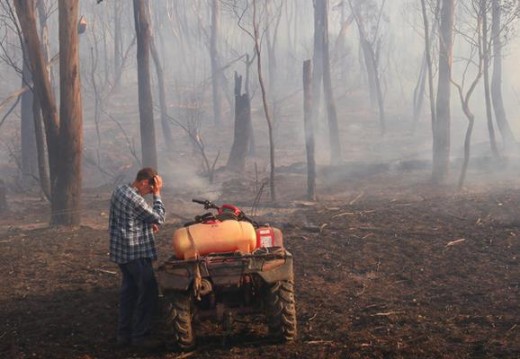
.
– end of article –
Tags: 1939 Black Friday Bushfires, bushfire fighting promise, bushphobic, duty of bushfire fighting, fire dependent, fire suppression, fire-provoking vegetation, firestick farming, fuel reduction burning, prescribed burning, save our forests, Threats from Bushfire, Victorian Bushfires 2009
Posted in Threats from Bushfire | No Comments »
Add this post to Del.icio.us - Digg
Friday, July 15th, 2011
The following article by Tigerquoll was initially published on CandoBetter.net on 20090312
.
During Victoria’s devastating 2009 bushfires, few will be aware that the Victorian Government’s so-called Department of Sustainability and Environment (DSE) allowed nearly all of the natural ecology of the northern half of Wilsons Promontory National Park (‘The Prom’) to burn at will.
Indeed ‘DSE’ has long been colloquially denigrated by rural Victorians as an acronym for ‘Department of Sparks and Embers‘ for such very reason.

Out of control, lack of resources?, or has The Prom Fire (now having destroyed 24,800 hectares of native habitat) in fact been deliberately left to burn?
DSE in collaboration with the Victorian Government’s CFA (Country Fire Authority) have protected private property at Tidal River and Yanakie.
Perhaps ‘CFA’ has similarly become an acronym for…’Culpable Fire Arsonists‘.
- What really has been going on at The Prom behind the fire barricade out of public view?
- Why was the small fire north of Sealers Cove not extinguished on Friday 13th February 2009, when it was nearly out?
- Why after three weeks with mild weather conditions has this wildfire not been put out?
- Why, ahead of more forecast hot winds, has DSE risked this fire continuing?
…government silence is deafening!
.
Is this really an opportunistic prescribed burn…thanks to lightning? Is it in fact because the DSE doesn’t want the fire out..not until its prescribed burn area is burnt?
A DSE operational fire planning document sourced from the Yarram Fire Distict (which includes The Prom) shows that most of The Prom that has now been burnt is in fact part of DSE’s ‘Planned Burns’ for 2009, 2010 and 2011 anyway. The DSE map (click link below) shows no fires history for the northern half of The Prom.
…’so quick let’s burn it, lest it burns!’
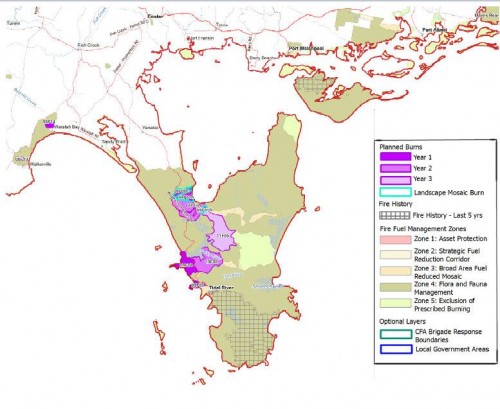 [CLICK MAP TO ENLARGE] [CLICK MAP TO ENLARGE]
Yarram Fire Operations Plan 2008/09 – 2010/11 – showing most of Wilsons Promontory colour coded for planned burning.
© Firemap Tue 14th Oct 2008
.
On this DSE planned burn map of The Prom, no areas are off limits from burning save the few villages and small pockets of private property and what the DSE has mapped as Zone 5 ‘Exclusion of Prescribed Burning’.
All other natural bushland areas of The Prom have been targeted by DSE for burning anyway.
This prescribed burning culture labels all bush hazardous ‘fuel’ and a demonic threat. Instead of putting out the fires in bushland they let the bush burn and all the native animals burn alive in the process.
They brag… ‘we save houses, the bush will grow back so what’s the problem?’
The ‘Department for Sparks and Embers’ is living up to its name.
But who’s responsible for the fauna?

.
.
Comments:
.
Is DSE helping developers get at the Prom??
March 4th, 2009 by ‘Prudence C’:
.
I would go further.
Are the developers that are driving this country to ruin actually after the Prom???
Does DSE, which is removing all rights from citizens to object to development, purposefully causing extinctions through burning so that soon it will be able to say, “Oh, all that land is degraded, it may as well be developed”?
I would put NOTHING past this government.
It should not be allowed to get away with what it has already done to Wilson’s PRom.
DSE is really just an old wood-feller’s hang-out. It should be closed down and something that cares about animals put in its place.
.
.
Vic DSE’s handling of Wilson’s Promontory fire defended
March 22nd, 2009 by ‘callum’:
.
You people have no idea what DSE try to do to get that fire out as so as they could! Where it was burn is very thick bushland and very high country you couldn’t get fire trucks in there. they tried droppin strike teams in but with the water bomber not make making a difference there was no point keep it going to without the water bomber the strike teams weren’t allow to stay on the fire front. so they had to wait until the fire got to where they could attack it. so before you start having a go at dse get the facts right. because the DSE did a great of protecting as much of the prom as they could. if they wanted the whole thing to burn they would have sat at the enterance to the prom and watched it burn! (Abuse removed – JS (Can DoBetter.net editor))
.
.
DSE’s prom effort was opportunistic prescribed burning
March 25th, 2009 by Tigerquoll:
.
Callum (above comment) claims the remote fire on Wilsons Promontory could not be put out.
The evidence is that on 13th March 2009 it was almost out due to rain, according to a timely online NASA satellite photograph. A fire truck approach for remote ignitions is obviously not going to work. It’s a bit like trying to connect up to the nearest fire hydrant in the bush. Such an urban fire fighting approach to remote ignitions is clearly flawed. The fact is that the Victorian government grossly under-resources remote fire fighting. This results in stuff all effective ignition detection (delegated volunteers rely on a goodwilled member of the public to ring 000 before fire trucks roll) and stuff all in effective response and suppression – if the truck hoses can’t reach the remote ignition, let’s sit and wait -it’s only bush. The resourcing of serious standby airborne Canadairs and Aircranes is beyond Brumby’s mindset, the let the bush burn culture is stuffed.
Questions to Callum, assuming he is duly informed about the actual fire response operation:
- Why did the “water bomber” not make making a difference to controlling the fire – especially on or before the 13th, before the wind speed picked up?
- Why were not extra water bombers including dedicated aircranes deployed immediately?
- Why weren’t the strike teams allowed to stay on the fire front and extra strike teams deployed, if necessary from interstate?
- Why did DSE have to wait until the fire got to where they could attack it?
- Why doesn’t DSE have an effective response strategy to remote fires?
(This was one ignition in favourable weaher conditions leading up to the 13th March).
- Was not most of the northern Prom burnt consistent with the 2009-11 fire plan of the Yarram Fire District?
- A lot of Victoria has thick bushland and very high country, moreso than the comparatively accessible (by air) coastal landscape of The Prom.
- How is DSE measured on its performance – by the minimal amount of area burnt due to fast and effective suppression? If so it has failed Victorians and their forests big time.
.
If DSE can be demonstrated to not have used every resource possible to quell this fire, the the presumption of opportunistic prscribed burning remains and the organisation deserves to be disbanded.
What’s the bet that Brumby’s Royal Commission ignores the Prom and the plight of ground dwelling fauna?
.
.
A large number of native
April 14th, 2009 by ‘Anonymous’:
.
A large number of native plant species in the Prom (and indeed, across Victoria) require fire to persist. There are however many species that will not survive fire (including animals obviously). The problem is that the species that require fire to disperse their seeds, sprout from epicormic shoots, flower like the native grass tree and for dormant seeds in the soil to be stimulated by fire do not survive the type of fire that spread through the Prom on the 13th March. Controlled fires are only lit when they can be managed and are either hot quick burns or slow not so hot burns. There are many ecologists that would give you this same view point. If you are correct and the DSE allowed this fire to burn then they should be held accountable but I seriously doubt that this was their conscious decision. They would be fully aware that many species would be lost.
While I understand your arguements, I think that you are being unreasonably harsh. The Prom fires were not immediately endangering property or person, of course the government would deploy all efforts in areas such as Healesville and Marysville where this was the danger before protecting native bushland. I think that this fire season was a unique situation and had there not been immediate danger to human life then I’m sure the management of the Prom fires would have been handled differently.
.
.
Let the DSE publicly justify its actions
April 14th, 2009 by Tigerquoll:
.
The desperately dependent myth that a few native plants require fire to survive is perpetuated to the extent that encourages DSE and CFA to incinerate all Victoria within cooee of a Eucalypt. Latching on to epicorimic growth seems to justfy incinerating ground dwelling mammalian habitat. Since when did a Potoroo sprout epicotic paws? DSE, to have any legitimacy beyond myth must provide independent ecological authority of the mandatory requirement for fire for species survival. I challenge the conspicuously ignored fact that any species of Australian fauna require fire to survive. Try lighting fire to you hand or house and see the reaction!
The bushphobic myth is defeatist! Burn the bush in case it burns!
Isn’t the real problem the fact that rural fire authorities are denied the right resources to instantly detect, respond to and suppress remote ignitions. Relying on calls to 000 and sitting in fire trucks is useless in quelling ignitions in rugged and remote country. It must be immensely frustrating to watch a fire grow into an uncontrollable monster because one is denied by government the right resources to deal with it while it is controllable. The considerable investment needed and asked for from government to fight fires while they are controllable, pale compared to the massive tragedy of letting a wildfire rip lives, property, wildlife and heritage to cinders because of government cost savings.
Then what a cheek to hear government thank the charities for picking up the tab and then to target mass burning of the natural environment just because government does not want to fund State of the Art fire fighting – which would instantly detect, respond to and suppress remote ignitions with military precision – saving lives, property, the rural way of life and our wildlife like genuine heroes.
The wildfire problem is likely to get worse with drought and arsonists more prevalent. Waiting for a remote ignition to reach a control line is what they in the 1940s. The risk and cost is too great to rely on a dad’s army response in the 21st Century, unless you have a mantra to destroy the Aussie landscape and create a neo-colonial parkland.
.
.
Your comments appear only half-educated
July 20th, 2009 by ‘artemis’:
.
No offence, but your comments appear only half-educated. A prescribed burn is done in pockets, so that an entire area is not burned off all at one time. This allows animals to continue to flourish in the wider area. This is what is called a “mosaic” effect. Which is why you see the DSE have burnt a little each year over the last few years. This is not “bush phobic” but takes into account the fact that the Australian bush has a complex and necessary relationship with fire for propagation and the DSE tries to work with the bush to encourage it at its natural state as best as possible without injuring or harming the humans that now inhabit it so profusely. In fact you will find that when prescribed burns as the Aboriginals carried them out stopped, certain species of animals that thrived and lived in the edges of them became extinct.
As fire is the natural state of the Australian bush, you will never stop it, the best we can do in our situation, is learn to harmoniously work with the land and manage it. If you understand it from this angle you will understand that prescribed burns cause no where near the damage to flora, fauna, the environment and humans as the huge deadly wildfires that occur if we don’t prescribe burn.
The DSE and the CFA are both committed to working to save the environment as much as possible, unfortunately too many people see them as the enemy – humans love to have a tangible enemy to attack, even if that means turning on one another when convenient. It will be nice when people finally realize that prescribed burns are much more green than they first understood.
.
.
Prescribed burning is based on unsupported myths
July 21st, 2009 by Tigerquoll:
.
Mosaic prescribed burns immediately around built assets (aka Asset Protection Zones) would seem sustainable. Building approvals only in low bushfire risk areas would seem sustainable. Permitting building construction out of non-combustible and fire retardant material would seem sustainable.
But the ‘bushphobic’ culture has pushed the boundaries and scale well beyond immediate protection of buildings. The scale of bush burning into remote wild parts of Victoria by DSE and the CFA is broadscale and massive and causing local faunal extinctions. Take a look at the DSE site
Take also one small example of a CFA fire district in Victoria. The Yarram Fire District in South Gippsland in its DSE Approved Fire Operations Plan [2008/09 to 2010/11] for 2500 hectares of bush to be deliberately burned.
The issue of burning the bush is indeed complex, yet the ecological complexity and impact is not understood or appreciated by DSE or CFA. How do you know that “DSE activities “allows animals to continue to flourish in the wider area”
Where are your statistics Artemis? Why are not independent zoologists with experts in Australia’s native fauna providing independent public reports supporting each Proposed Plan Burn by the DSE and CFA across Victoria? Too embarrassing, especially when these get out of control 1 in every 2? It is because the DSE and CFA have cumulatively destroyed more native habitat that any other threatened process? Look at Wilsons Promontory in 2009 and 2005! Default prescribed burning from the convenience of lightning. No building threatened so let the bastard – saves us the work anyway on the Fire Plan and we can always argue the old “it was burning in inaccessible country” excuse – works every time, guaranteed!
Controlled limited ‘mosaic’ burning that excludes flora species and ecological systems vulnerable or intolerant to fire is the PR spin. But on the ground prescribed burning is not an exact science. It is not undertaken scientifically nor supervised scientifically or able to be independently verified as compliant. The DSE or CFA have no independent public watchdog. They are a law under themselves and they know it. Weekend warriors end up torching most of the prescribed burns – “this’ll do!” If it gets out of control, we’ll deal with it but actually it will save us bother next time and minimise the fire risk next summer.
The Aboriginal firestick burning is another excuse used to justify deliberate arson of wild landscapes remote from buildings is another old school fire management myth, lacking scientific merit. Since when did ancient Aborigines drop aerial incendiaries over vast inaccessible areas every year?
The Armageddon myth is another bushphobic alarmist excuse to try to justify slashing and burning as much bush as possible ‘before it burns’ every seven years or so. This way no bush is ever allowed to live beyond seven years. The main reason huge deadly wildfires occur is because the fire authorities take too long to detect the ignitions take too long to respond, don’t have the right tools to suppress remote ignitions fast and effectively.
The DSE and the CFA are both committed to perpetuating the status quo, let alone give a toss about the natural environment.
.
.
Logging is drying our forests!
July 20th, 2009 by ‘Anonymous’:…
.
By “managing” our forests and clearing native vegetation, along with the conditions of drought and climate change, we are actually making them drier and less dense, and thus adding to the risk of mega-fires.
While our State government continues to permit the logging and thinning of our native forests and water catchment areas, the public can do little to prevent further mega fires.
The dry conditions means that trees suffer and compete for water. They lose their leaves, or die, thus exacerbating the dry undergrowth problem. Instead of moisture, forests continue to become more vulnerable. It is then a cycle downwards to damaged ecosystems, and thus more fire dangers.
.
.
Broadscale frequent prescribed burning is a threatening process
July 21st, 2009 by Tigerquoll:
.
Indeed, logging, thinning and frequent burning (forest practices) over Australia’s 220 year colonial history have and continue to destroy the integrity of our native forests and force our native fauna closer to extinction. Colonial ‘clearing’ for agriculture and building materials destroyed most of south eastern Australia’s natural landscape. Neo-colonial practices including unchecked urban invasion and prescribed burning continue to do destroy what’s left.
Australia’s original natural landscape is characterised by varied topography and varied mosaics of different vegetation types. Broad scale destruction of native vegetation across south eastern Australia has reduced the remnant forest and heath habitat into fragmented and isolated islands. Many specific habitat types are now threatened and endangered as a consequence. Wet schelophyll has being transformed into dry schlerophyll. Note the fire resistent species that return after a fire – Acacias (wattles), tea tree and Eucalypts. These then dominate the new growth and when the next fire occurs they burn more intensely and exacerbate the wildfire. Frequent prescribed burning makes our remnant forests more susceptible to wildfire. Frequent prescribed burning and uncontrolled broadscale bushfire are by area and impact are responsible for the loss of our remaining biodiversity and ecological values across south eastern Australia.
This is even though prescribed burning has been found not to prevent ember attack – the main cause of wildfire spread in extreme bushfire weather conditions! Frequent broadacre burning policies have limited effectiveness at mitigating wildfire risk (its intended aim). The previous “NSW Rural Fire Service Commissioner, Phil Koperberg, echoed similar sentiments when faced with criticism after the 2002 fires: ‘Unless you’re going to keep all of New South Wales hazard reduced to a point where there is no fuel on the ground…we’re going to have fires’ (McKey 2002).” SOURCE: http://www.australianreview.net/digest/2003/02/brandes.html
ACB Submission to the Teague Commission on Victoria’s 2009 Bushfires
The Australian Centre for Biodiversity (ACB) at Monash University has made a submission to Teague Commission on Victoria’s 2009 Bushfires, and addresses the fundamental question: ‘Can fire and land management practices and policies be modified to minimise the future risk of similarly catastrophic bushfires without compromising Victoria’s native ecosystems and the biodiversity that they support?’
ACB in its submission, has offered the following warnings of how broadscale frequent burning threatens our native forests:
“Natural fire is a complex physical process that affects organisms, communities, and landscapes in various ways. The spatial and temporal variability of these impacts depends on the intensity and frequency of fires in an area, that is, the fire regime.”
“Inevitably, after a major bushfire, there are calls to increase the amount and frequency of fuel reduction burns. However, increasing the rate of fuel-reduction burns is, in effect, changing the fire regime in an ecosystem and may have substantial ecological implications.
“The application of fuel-reduction burning to mitigate fire risk, therefore, needs to be critically questioned on two fronts.
First, will increasing the frequency and amount of prescribed burning reduce fire risks at the landscape scale?
Second, how will changing the fire regime through increased fuel-reduction burning impact on native ecosystems? Will increasing fuel-reduction burning lower fire risks?
“Theoretical studies have also shown that fuel-reduction burning at the landscape scale can reduce the risk of large, catastrophic fires. However, these studies make important assumptions about the other point of the fire triangle: climate. Under most reasonable climatic conditions, fuel reduction burns done sufficiently frequently may reduce the risk of large fires. However, under extreme climatic conditions, such as those that preceded Black Saturday, this may not hold. As of Friday, 6 February 2009, approximately one-third of Victoria’s public lands had been subjected to fuel-reduction burns since 2003; that is, ~5% of public lands were subjected to fuel-reduction burns each year. This was the target set in an earlier Parliamentary Enquiry and clearly did not prevent the Black Saturday fires. Modeling studies suggest that the amount of fuel reduction burns would need to be doubled, at least, to have any potential for avoiding similarly catastrophic fires if conditions of such extreme fire danger re-occur in the future.”
“Increasing fuel-reduction burning to proposed levels (10-15% of public lands per year) would reduce habitat diversity by homogenizing the regional fire regime. The diversity of habitats and their mosaic distribution across the Victorian landscape is a critical component in maintaining local and regional biodiversity. The interdigitation of sites differing in their susceptibility to fire provides temporary refuges for animals that can move away from fires and later recolonise their original sites. More frequent fuel-reduction burning will change the structure and composition of the understorey vegetation. While many animals may be better able to survive the low-intensity fuelreduction, the resultant vegetation may be poor-quality habitat.”
“Applying a single prescribed burning policy to Victoria’s public lands will disadvantage a large proportion of the native biodiversity and reduce local and regional habitat diversity. Shifting
toward more homogeneous landscapes through increased prescribed burning will be detrimental to the long-term conservation of biodiversity in Victoria.”
“Increased prescribed burning may reduce fire risks in some years, but is unlikely to have any effect in those years with extreme climatic conditions similar to those of 2009.”
“A uniform and widespread increase in fuel-reduction burning across Victoria’s public lands will likely have negative long-term impacts on the native flora and fauna.”
ACB’s recommendation:
“We recommend that the State government consider a more nuanced policy that acknowledges the spatial complexity of Victoria’s landscapes and the values associated with them. We recommend that increased prescribed burning be focused in high-risk areas directly surrounding towns to minimize threats to people and property. However, for more remote, unpopulated areas, where the primary values are biodiversity and timber, we believe that fire management plans should be based on the best available science, that they should be consistent with the appropriate historical fire regimes, and that they provide an integrated, long-term vision for Victoria’s natural heritage.”
SOURCE: www.biolsci.monash.edu.au/research/acb/docs/teague-commission.pdf
.
.
Conservation biologist disputes that burn-offs harm ecology
May 1st, 2010 by ‘Anonymous’:
[Subject was: Myth? are you serious? – JS]
Myth? Are you serious? Perhaps you should learn the basics of Australian ecology and the critical role of fire for the majority of Australian flora before you go and bad mouth the authorities who do their best to save your homes. I know there is a lot of debate but you can’t base your arguments from what you hear in the media. I am a studying ecologist and conservation biologist, you need to hear the real truth from the experts – not the damn reporter who gets paid to write what ever will sell papers. without fire the prom will disintegrate. sure you feel sorry for the cute and fluffy animals that may be caught in these fires but if you had any decent knowledge you would know that our native wildlife have evolved with fire and they wont all perish, They have adapted the most interesting adaptations and behaviours that allow them to escape or rebuild their populations at amazing rates after fire. For most, if not all, of the Australian biota, fire is beneficial!
.
.
Feeling “sorry” for the “cute and fluffy animals” is sickening
May 1st, 2010 by Milly:
.
Feeling “sorry” for the “cute and fluffy animals” is sickeningly patronising and degrades our wonderful and diverse wildlife. How could you be studying ecology and not have some appreciation of our stunning and awesome range of unique species in Australia, and their tragic decline? It is ecologist like you who, without peer support and without having a shred of compassion or empathy with living creatures, become paid to “manage’ wildlife with fire-arms! (Such as Canberra’s kangaroo managers[1]).
There was no capacity for fires to be as large or as intense as what we are seeing today. Land clearing and logging have made soils and undergrowth drier and more open for oxygen, increasing fire risks.
Since European settlement, the landscape has changed dramatically. Trying to replicate Aboriginal fire practices in southern Australia would unfortunately now be a risky experiment. European land management has seemingly done everything necessary to turn the Australian landscape into a moonscape. The argument that we should engage in widespread and regular burning of the forest because that’s what Aboriginal people did for years is, as the 2003 bushfire inquiry put it, “a highly attractive philosophy”. However, we simply do not know enough about traditional burning in southern Australia to be able to re-create an Aboriginal burning regime.
Firstly, in most parts of Australia, we don’t know how Aboriginal people used fire. Secondly, since European occupation, ecosystems have been changed so much that Aboriginal burning would no longer be possible. The native animals that ate and buried plant material have largely disappeared, so there is a lot more flammable vegetation in the bush now than there was before Europeans arrived.
Many wildlife have traits that enable them to survive fire. Often they are adapted to specific fire regimes, determined by intensity, frequency, season and scale. However, inappropriate fire regimes may have undesirable consequences including declines or local extinctions of biodiversity.
Footnotes
See:
^Roo culls lead to tourism boycott calls of 6 Jul 09
^RSPCA rubber-stamp in Majura Kangaroo kills unworthy of this organisation’s aims of 17 Jun 09
^Fitzgibbon’s Massacre – 9th May 2009 of 14 May 09
^It is clear that the government is interested in “managing” wildlife such as kangaroos out of existence of 13 May 09
^ACT Environment Commissioner unqualified to condemn kangaroos of 16 Apr 09
^Majura kangaroo killings: Another Belconnen Cover-Up? of 15 Apr 09.
.
.
Bushfire authorities: underfunded dad’s armies playing with fire
May 2nd, 2010 by Tigerquoll:
.
In response to comment above: “Authorities who do their best to save your homes.”
What is the latest excuse for these ‘bushfire authorities’ failing to save homes in Victorian in February 2009?
The simplistic strategy applied to rural fire fighting across Australia is to burn the bush before it burns. Get rid of the bush (fuel), with no thought to the impact to wildlife of burning and to the sterile ground cover landscape such practice leaves.
Bushfore authorities do this to hide the blatant fact that they are incompetent at suppression fires before they cause serious damage. By the time the detect the fire and get to it, it is too late.
As for bush being a natural asset would even occur to them. Only houses matter because they are the only thing they know how to defend, and they can’t even get that right. It is not the volunteers at fault, it is the Government dependent on volunteers and token funding that is at fault. Try taking that approach with the police?
Brumby and Rudd were ultimately responsible for the 17 Victorian deaths. They simply avoid funding a serious emergency force to prepare for and to mitigate such natural disasters and bush arson. A pre-1939 Black Saturday approach to bushfire fighting is gross public negligence. I hope those affected take up a class action and sue the pants of the government authorities. Only then will the billions needed to to do a proper fire fighting job be invested by Australian governments rather than paid out after the tragedy and rely on volunteer charities.
Fire is beneficial is only beneficial for those with a penchant for lighting fires. If it isn’t doing too little too late to put wild fires out, the rest of the year is spent lighting new ones. If there is no fire there is nothing to do, so we better light a fire and look busy. Drip torches and airborn incendiary – burn the lot seem to be the Neanderthal thinking!
Didn’t learn much from Ash Wednesday 1983 or the hundreds of fires since. Bloodly uselfess lot these dad’s army. No I don’t expect a fire truck to turn up outside my house if there is a fire. I know here I stand and it’s every man for himself.
‘Fire ecology’ what a farcical term for State-sanctioned arson. Well name one species of flora or fauna made extinct due to lack of fire? – there’s a good one for your so called ‘ecology’ course.
.
– end of article –
Saturday, July 9th, 2011
Originally posted February 23rd, 2009 by Tigerquoll on Candobetter.net
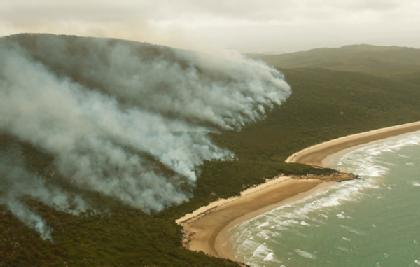
Eastern side of Wilson’s Promontory (coastal Victoria) near where
the fire started. Photo: John Woudstra
.
I have been monitoring the Jan-Feb 2009 Victorian bushfires from NSW and have turned my attention to the bushfire management in a natural area – Wilsons Promontory.
I note satellite observations of the fire with concern showing the lighting ignition on the east coast started 9th February, but had almost extinguished itself by the 13th. Then a wind change drove it out of control. A week later it has burnt out 22,000 hectares (almost 50% of our precious 50,000ha Prom)!
While the Country Fire Authority (CFA) has paid special attention to non-imminent bushfire risks to rather distant private property. The CFA says “the fire does not currently pose a threat to the Yanakie community.” Backburning the Prom is given as the only bushfire response strategy. So do we interpret this as a noncommittal response by the CFA for the Prom – that is since no human lives or private property are at threat, the CFA’s bushfire response is to just ‘monitor’ the fire and put out the spot fires threatening private property to the north?
“I interpret this bushfire management by Victoria’s CFA as one that respects only human life and property, but does not rate the natural asset values of fauna and flora habitat of the Prom with any respect.”
.
The CFA reports read as though CFA policy for active and damaging bushfires in important conservation areas is to wait for rain, but otherwise ‘let it burn’.
And yet the Bureau of Meteorology forecasts hot and windy conditions for tomorrow Monday, 23 Feb 2009.
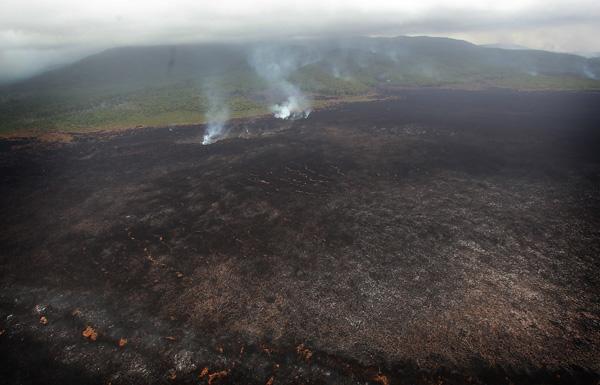
Wilsons Promontory where thousands of hecteres have been burnt.
Photo: John Woudstra
.
I interpret this bushfire management by Victoria’s CFA as one that respects only human life and property, but does not rate the natural asset values of fauna and flora habitat of the Prom with any respect. It seems at best an opportunity for de-facto hazard reduction that it would normally not get permission to do, and at worst an inconvenient distraction for CFA crews.
If this is the prevailing attitude of rural firefighting then clearly the CFA has no interest in natural assets, and no mandate to protect them from fire in the same passionate way it does private property? There seems no difference in approach or skill set by the CFA to that that would be exercised by urban fire brigades.
So why do we have a Country Fire Authority? Because professional fire brigades are expensive.
Whereas luring local volunteers is cheap for government, so long as the propaganda is correctly instilled – ‘locals protecting local assets…’
Government has a bet each way. If the local volunteers put out the fire and save lives and property, they are heros and the organisation is justified. If the local volunteers fail and people die, governments defend the local volunteers for doing their best and reject criticism of fire fighting as criticism of local volunteers, and pleads the unAustralian line.
With this premeditated social strategy, successive governments have got off scott free when people die in bushfires. Government bushfire fighting strategy is this to have a bet each way and when catastrophe eventuates to hide behind the ‘Volunteer Firefighter Facade…
Such has become the politics of negligent government. For decades hiding behind the ‘Volunteer Firefighter Facade has proven effective in persuading a gullible media, so the policy and practice perpetuates in absence of an independent public watchdog.
Public class action for damages is long overdue.
On this basis, it is overdue for the CFA to be incorporated within the urban fire brigade structure. While this initial structural change won’t save Victoria’s vast tracts of wildlife habitat in the short term, it will sure will remove the false premise to the community that the CFA respects and defends natural wildlife habitats.
What does Victorian Government’s Department of Sustainability and Environment have to say for itself? It is charged with the Promontory’s protection.
See also: “Crews unable to slow Wilsons Promontory blaze” on ABC online on 17 Feb 09, “Huge blaze threatens the very heart of the Prom” in the Age of 19 Feb 09.
Thursday, June 2nd, 2011
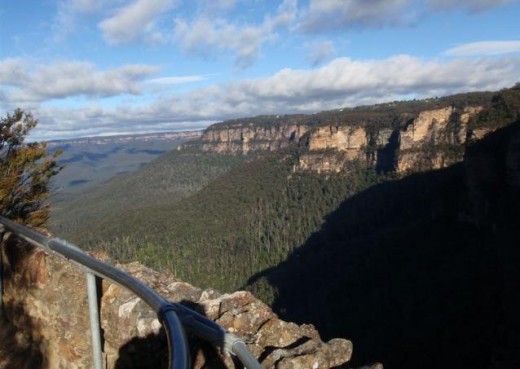 Jamison Valley from Sublime Point, Leura
(Blue Mountains, New South Wales, Australia) Jamison Valley from Sublime Point, Leura
(Blue Mountains, New South Wales, Australia)
.
For those who have purchased an escarpment-edge bush block in Blue Mountains villages of Leura, Wentworth Falls or Katoomba, who have ‘arranged‘ for native escarpment habitat to be killed in order to gain property views to the magnificent Jamison Valley, such actions are selfish and contribute to the ecological vandalism and disappearance of important and scarce escarpment habitat.
For others enjoying the Jamison Valley naturally on foot, to look back up at the Leura escarpment has become an ugly one dominated by increasing housing development.
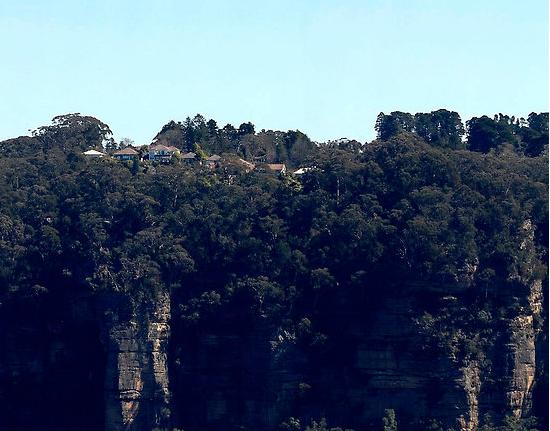
Views are bidirectional, but try explaining that to a property developer or to those real estate agents who only appreciate the sales commission.
On the spectacular escarpment fringe of the much valued village of Leura in the much valued Blue Mountains, not only have the fire-lighters taken a fancy at setting fire to nearby prized escarpment bushland, but the property developers have been in with the bulldozers.
The Blue Mountains (city) Council has for decades signed off on developer applications for clifftop development and consequential deforestation. More recently, Blue Mountains (city) Council continues to happily signed off on approval of applications from subsequent clifftop property owners to ‘hazard reduce’ the surrounding escarpment bushland ~ either to improve the views or to save money having to bushfire protect their properties.
Either way, valuable limited habitat along the Blue Mountains escarpment overlooking the Jamison Valley continues to disappear for new selfish housing views.
All along the Jamison Valley escarpment, the following photos tell a tragic story of the selfish developer destruction of the Jamison Valley Escarpment …
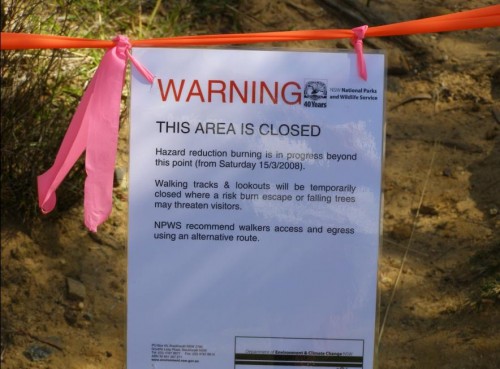 Wildlife Service ‘hazard reduction’ burn notice for Sublime Point escarpment at the end of Willoughby Road, Leura back on 15th March 2008.
(click photo to enlarge) Wildlife Service ‘hazard reduction’ burn notice for Sublime Point escarpment at the end of Willoughby Road, Leura back on 15th March 2008.
(click photo to enlarge)
.
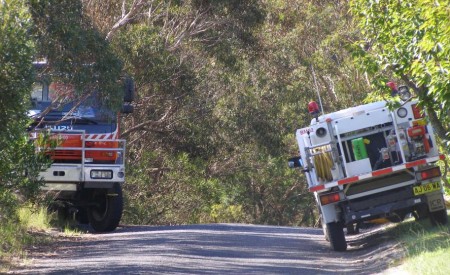 Warrimoo Rural Fire Service set up to conduct hazard reduction at Sublime Point, Leura (Carleton Road, Leura, 15th March 2008). Warrimoo Rural Fire Service set up to conduct hazard reduction at Sublime Point, Leura (Carleton Road, Leura, 15th March 2008).
.
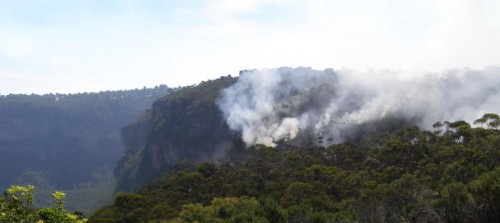
Rural Fire Service setting fire to escarpment vegetation at Sublime Point on the Jamison Escarpment, Leura. (Photo from Willoughby Road,Leura, 15th March 2008).
.
A year later again at Sublime Point…
.
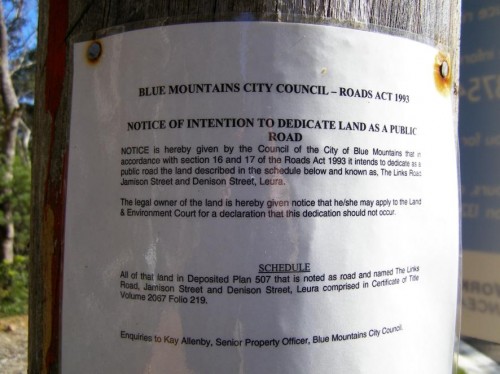 DECC Wildlife Service ‘hazard reduction’ burn notice for Sublime Point escarpment again on 24th March 2009, almost exactly a year to the date. DECC Wildlife Service ‘hazard reduction’ burn notice for Sublime Point escarpment again on 24th March 2009, almost exactly a year to the date.
.
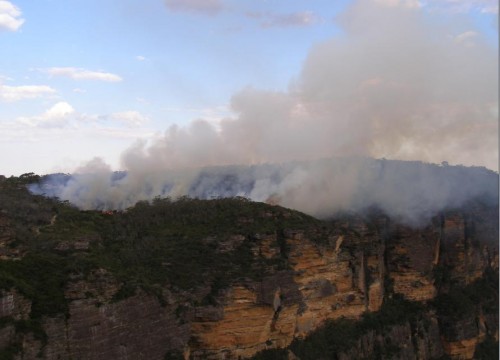 Blue Mountains Wildlife Service ‘hazard reduction’ burn of the Jamison Escarpment at Sublime Point 24th March 2009 Blue Mountains Wildlife Service ‘hazard reduction’ burn of the Jamison Escarpment at Sublime Point 24th March 2009
.
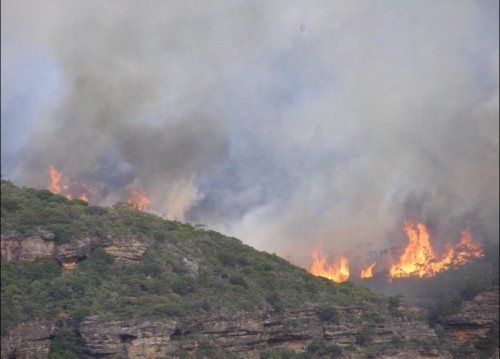 Blue Mountains Wildlife Service ‘hazard reduction’ burn of the Jamison Escarpment at Sublime Point 24th March 2009. Blue Mountains Wildlife Service ‘hazard reduction’ burn of the Jamison Escarpment at Sublime Point 24th March 2009.
.
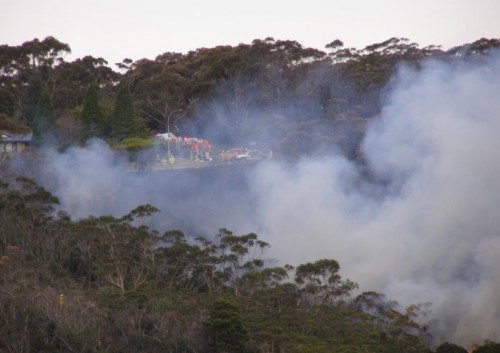 Fire-lighters watching on as their blaze gets out of control at Sublime Point 24th March 2009.
(Click photo for enlargement) Fire-lighters watching on as their blaze gets out of control at Sublime Point 24th March 2009.
(Click photo for enlargement)
.
.
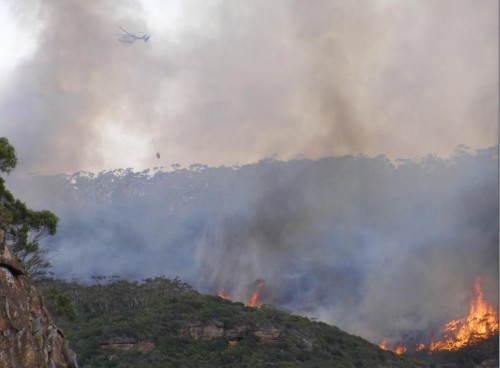 Same ‘hazard reduction’ burn out of control, requiring expensive and embarrassing helicopter water-bombing to stop the fire spread down into the protected Jamison Valley Same ‘hazard reduction’ burn out of control, requiring expensive and embarrassing helicopter water-bombing to stop the fire spread down into the protected Jamison Valley
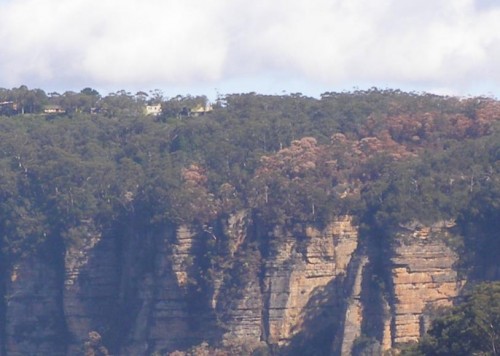 East side of Sublime Point (5th April 2009) showing burnt vegetation, where the HR burning had escaped and nearly entered down into the Jamison Valley.
(The media spin by bushfire management was that this section was arson, but not surprisingly the culprit was never found). East side of Sublime Point (5th April 2009) showing burnt vegetation, where the HR burning had escaped and nearly entered down into the Jamison Valley.
(The media spin by bushfire management was that this section was arson, but not surprisingly the culprit was never found).
.
nec.
Meanwhile, property developers at Sublime Point, a block away…
.

Leura’s recently approved and created ‘ The Links Road‘ (31st May 2008) following Council approved destruction of escarpment vegetation and subsequent subdivision ready for escarpment housing..with views.
.
Meanwhile, further along Cliff Drive at Katoomba…
.
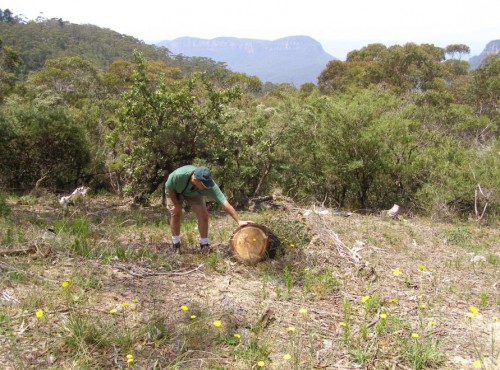 Editor inspecting native escarpment site on Cliff Drive, Katoomba back on 12th January 2008 that had been recently slashed by the Wildlife Service.
It just so happened that a house opposite on Cliff Drive was up for sale and would benefit from the fresh views of the Jamison Valley. Editor inspecting native escarpment site on Cliff Drive, Katoomba back on 12th January 2008 that had been recently slashed by the Wildlife Service.
It just so happened that a house opposite on Cliff Drive was up for sale and would benefit from the fresh views of the Jamison Valley.
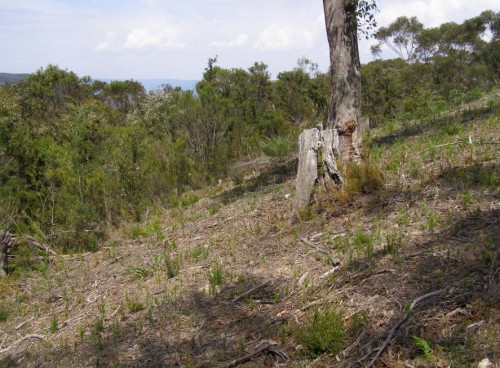 Same site, same date. Same site, same date.
.
 Seven months later, a few hundred metres west along Cliff Drive Katoomba,
some developer gets escarpment views towards Nellies Glen approved,
or is it more a case of ‘overlooked‘ by Blue Mountains (city)Council? Seven months later, a few hundred metres west along Cliff Drive Katoomba,
some developer gets escarpment views towards Nellies Glen approved,
or is it more a case of ‘overlooked‘ by Blue Mountains (city)Council?
.
.
.
-end of article –
Tags: Blue Mountains City Council, Blue Mountains western escarpment, Blue Mountains World Heritage Area, bushland housing, hazard reduction, housing encroachment, Jamison Valley, Katoomba, Leura, Links Road, NPWS, prescribed burning, Sublime Point, Wentworth Falls, Wildlife Service
Posted in Blue Mountains (AU), Threats from Bushfire, Threats from Development | No Comments »
Add this post to Del.icio.us - Digg
Thursday, May 26th, 2011
[The following article has been borrowed from a section of a previous article on this website: ‘Blue Mountains copping government-arson‘, since this important message has ramifications beyond the natural areas of the Blue Mountains].
.
– – – – – –
.
.
From the frying pan…
.
When bushfire management can contrive no other excuse for setting fire to native vegetation, like when native vegetation is many miles away from human settlement and so poses no direct threat; out comes a concocted academic theory called: ‘ecological burning ‘. Over how many beers?
When those in whom our community trusts to put out bushfires, decide instead to start setting fires to bushland, and descend instantly into a betrayal of that that trust, to whom can our community entrust to put out bushfires? Government has been proven to suck.
What has happened to ecological values of the bush and the sense of urgency to put out bushfires that threaten both it and us?

.
‘Ecological Burn’ Theory
.
- The ‘ecological burn’ theory starts with the premise that because humans have observed that the Australian bush ‘grows back’ (eventually) after a bushfire, it may be concluded that the Australian bush can tolerate bushfires. This hypothesis relies on evidence that selected species of Australian germinate after smoke and fire and the example of epicormic growth of many Eucalypts after fire.
- The deductive fallacy of this theory is that all the Australian bush is bushfire tolerant.
- This deduction is then extended by unsupported assumption that since the Australian bush is bushfire-tolerant, bushfire must be an integral natural process to which the Australian bush has become adapted to bushfire.
- The assumption is then extrapolated to assert that bushfire is indeed beneficial to the Australian bush.
- The assumption is then stretched even further to conclude that without bushfire the Australian bush will be adversely affected.
- The ecological burn theory then prescribes that by burning the Australian bush, whether by natural or unnatural means, the biodiversity of the Australian bush will be improved.
- The deductive fallacy goes further, to suit the motives of the fire-lighters. The outrageous generalisation is made that all the Australian bush must be burnt at some stage for its own ecological benefit.
.
So the ‘Ecological Burn’ mantra has become:
‘Go forth and burn wilderness. It’ll grow back. It’ll do it good.‘
.
.
Habitat ‘fuel’ gone…so it wont burn now!
.
The perverted irrational logic that Australia’s native vegetation has adapted to recover from bushfire is akin to claiming the human body is adapted to recover from injury such as burns. A wound may heal but no-one seeks to be injured in the first place. And not all wounds heal. A third degree burn to more than 50% of a human body is almost a certain death sentence. What percentage of a wild animal’s body can be burnt and the animal still survive? That’s a perverted question for the fire-lighters.
Broadscale hazard reduction is not mosaic patch-work fire. It is not creating a small scale asset protection zone around the immediate boundary of a human settlement. It is wholesale bush arson that is driving local extinctions. Ever wonder why when bush walking through the Australian bush so few native animals are seen these days? Their natural populations have been decimated through two centuries of human harm – mainly poaching, introduced predation and habitat destruction including by human-caused bushfires and human-abandoned bushfires.
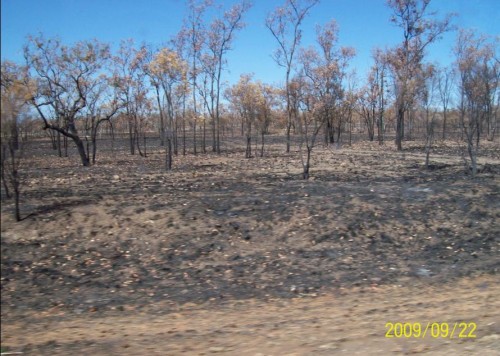 Broadscale incineration of native bushland across northern Queensland
by the Rural Fire Service Queensland.
Habitat ‘fuel’ gone ~ so it won’t burn now! Broadscale incineration of native bushland across northern Queensland
by the Rural Fire Service Queensland.
Habitat ‘fuel’ gone ~ so it won’t burn now!
©Photo by Ann Jurrjens, 20090922.
(click photo to enlarge, then click again to enlarge again).
..
.
.
.
Likely Origins of the ‘Ecological Burn’ myth
.
The concept of the ‘ecological burn’ sounds like the academic contrivance that it is. It is an outpouring from a handful of forestry academics who have successfully sold their consulting services to government under a similarly contrived expertise of being ‘fire ecologists‘ or ‘fire scientists‘. Well, at least ‘garbologists‘ work for a living.
After a major bushfire, an affected and sometimes devastated public cries for answers and the media cash in with their newspaper-selling witch hunt. The responsible government politicians and department directors of the bushfire management deflect accountability away from themselves by instigating a tried and tested ‘bushfire enquiry‘. Those enquiries seek expert evidence and so the ‘fire ecologists’ come out of the woodwork, professing expert insight into the reasons for uncontrolled bushfire and contriving theories for better bushfire management. They invariably proclaim ‘I told you so!
With the frequency of uncontrolled bushfires year after year, there have been so many enquiries across Australia, sufficient to fill bookshelves; each one wastefully gathering dust. Yet with the almost annual disaster recurrence somewhere across Australia, the relevance of ‘fire ecologists’ has morphed fire ecology into an almost full-time occupation – generally on the payroll of the government agencies seeking to justify excuses why they didn’t put out the bushfires in the first place.
The origins of ‘fire ecology’ and to the ‘ecological burn’ theory may be at least traced back to Victoria, an Australian state with perhaps the worst record of bushfire management in the country. During 1999 a series of ‘Fire Ecology Workshops’ were held at Country Fire Authority stations across the state. In that year the ‘Interim Guidelines an Procedures for Ecological Burning‘ was published by Victorian Government’s departments: Natural Resources and Environment and Parks Victoria. References to this and related documents may be found by following the links under References below.
It must have been like an evangelistic mission by these new ‘fire ecologists’, leveraging the common human terror of fire into a way of dealing with that fear once and for all. The final solution would go beyond ‘back-burning‘, beyond the ‘controlled burn‘, beyond ‘hazard reduction‘. It means burning the bush before it burns; but this time on a massive scale, taking the fire-fight to wilderness.
The ‘ecological burn’ theory has gone further. It has brainwashed fire-fighters and natural land managers into believing that burning the bush is indeed good for the bush, good for biodiversity. This is a paradigm cultural shift to a sense of ecological righteousness – by burning the bush you are doing biodiversity a favour. And the fire scientists’ proof of their theory is down to the epicormic growth and the selected native plant species shown to be fire-tolerant, and with that fire-tolerance must be ecologically sustainability. As soon as some green regrowth occurs, they are out taking photos to support and promulgate their theory. ‘Look it grows back’ they claim. Except that these same species that recover from fire have ended up dominating the natural landscape.
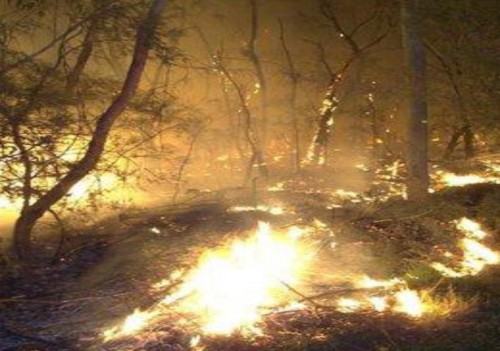 Fire-Lighters’ bliss
.
Fire-Lighters’ bliss
.
‘A Firelighters’ Bliss‘:.
‘a state of profound satisfaction in lighting a bushfire, the equivalent happiness and joy in doing so, a constant pyromaniac state of mind, undisturbed by gain or loss, so long as the lit bush burns fiercely’. i.e. the aroused state of ignition frenzy by either a closet, suspected or convicted bush-arsonist!
.
So forget Aboriginal traditional mosaic burning theory – so passé and so ineffective (below napalm baseline). So the message is officially clear, if you want to avert calamities like Black Friday, Black Saturday and the demonising of the rest of the days of the week, burn the bush in swathes, lest it burn you first. The theory is ecological satanism. It is up there with the Y2K bug. It has led a wholesale conversion of bush fire-fighters into fire-lighters on a grand scale akin to scientology’s hold on young people in the 1970s. It has culminated in an escalation of prescribed burning to an extent well outside any reasonable justification for protecting human life and property from the risk of bushfire. The ‘ecological burning’ extremists evangelise is that burning should be ‘strategic’ and for strategic zones spanning thousands of hectares of wilderness to be targeted for burning. What they avoid problem-solving is why they don’t put out the ignitions in the first place.
‘Ecological fire’ is a myth that has festered into the greatest ‘eco-crime’ in Australia’s history, second only to 19th and 20th Century widespread clear-felling. The ‘ecological fire’ myth is the most devastating driver of man-made extinctions plaguing Australia in the 21st Century.
.
A Test for ‘Fire Ecologists’:
.
Name one case study in Australia published in a peer-recognised scientific journal… in which independent wildlife ecologists have conducted proper before-and-after field tests of fauna-and-flora-biodiversity…where natural (pre-1788) biodiversity has been found to flourish… as a provable result of a broadscale ecological burn!
.
In August 2000, possibly the country’s chief druid of bushphobia, Kevin Tolhurst, produced a report seeking to justify the previous year’s setting fire to most of the Mount Cole State Forest, situated over 20km east of the town of Ararat in Victoria’s central west district. At the time, Tolhurst was part of the School of Forestry at the University of Melbourne.
Part of the report included, Appendix 3: Guidelines for the Ecological Burning in foothill forests of Victoria, in which an overview of the Mt Cole Case Study was provided. Notably, this report is provided not found on the University of Melbourne website, but that of the Department of Primary Industries of Victoria website. Clearly the ‘ecological burning’ concept stems not from preferred prestigious academic credentials, but moreso from politically motivated Primary Industries exploitive expedience.
The primary vegetation types targeted were ‘grassy dry forest’ and ‘herb-rich foothill forest’ which had not been burnt for an estimated 35 years, according the Natural Resources and Environment (Vic) corporate GIS database.
.
Tolhurst’s report states:
“Mt Cole State Forest was selected on the basis of having extensive areas of long-unburnt vegetation. A couple of areas within the forest had already been earmarked for prescribed burning from a fire-protection point of view. Mt Cole is an extensive area of easily defined forest with a wide range (of) vegetation types, ages, uses and values. The landscape management unit used in this example is about 32,000 ha in extent if which about half is forested and the other cleared for agriculture. There is little functional connection between this forest area and any other forest.”
“..The broad ecological management objective for Mt Cole State Forest, as part of the Midlands Forest Management Area is to : ‘Ensure that indigenous flora and fauna and communities survive and flourish throughout the Midlands Forest Management Area.”
…Flora and Fauna Inventory:
“Species found in study area as a result of a ramble survey of approximately 20 minutes at each location.”
.
Clearly, the motive underlying the so-called ‘ecological burning’ was the irrational fire-lighting cult fear of ‘long-unburnt vegetation’ daring to remain unburnt or so long – a symptom of bushphobia. ‘From a fire-protection point of view’ is the real motive and so it was convenient to just set fire to the lot. So some 32,000 hectares of a surviving island of native habitat was torched. After decades of agricultural land clearing Mt Cole State Forest had indeed been sadly reduced to having “little functional connection between this forest area and any other forest.” So why not just wipe the rest off the face the Earth? It probably stood out like a sore thumb coloured red for ‘high risk on ‘strategic’ CFA maps anyway.
And the blanket ‘ecological burn’ would see to it to ‘ensure that indigenous flora and fauna and communities survive and flourish throughout the Midlands Forest Management Area.”
Perhaps, post-burn, a similar 20 minute flora and fauna inventory was conducted in the CFA truck with a few tinnies, playing… ‘first-to-spot-the-first-bloated-blackened-wombat‘.
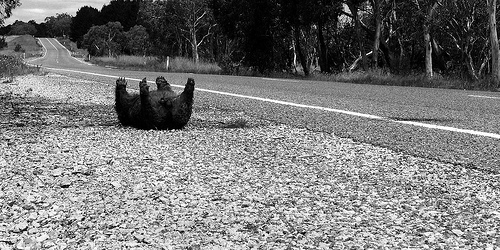 Dead Wombat Dead Wombat
.
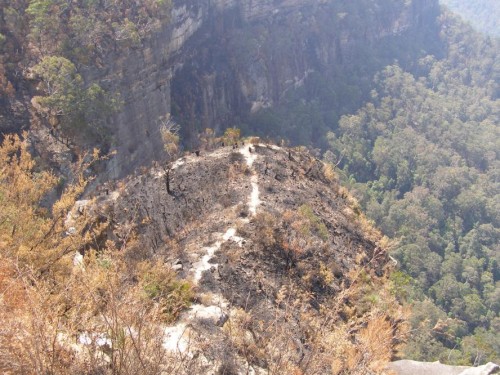
Defacto Hazard Reduction on the Grose Valley Escarpment, 2006
The fragile yet complex and vital soil biota of the escarpment built up over perhaps centuries,
gone after subsequent rain.
Habitat ‘fuel’ gone ~ so it won’t burn now!
(click photo, then click again for zoom details)
[Photo is ours, so free in public domain]
.
.
.
.
References
.
[1] ‘ Management of Fire for the Conservation of Biodiversity‘ – Workshop Proceedings, May 1999, Fire Ecology Working Group (Gordon Friend, Michael Leonard, Andrew MacLean, Ingrid Sieler), Natural Resources and Environment, Parks Victoria, ^ http://www.dpi.vic.gov.au/CA256F310024B628/0/0F55F0F75BFB3FCECA257231000D9F4D/$File/Mgt+of+fire+for+Cons+and+Biodiv.pdf.
.
[2] ‘Appendix 3: Guidelines for the Ecological Burning in foothill forests of Victoria’, Department of Primary Industry (Victoria) website, ^ http://www.dpi.vic.gov.au/CA256F310024B628/0/CC122443185E3E38CA257231001076A7/$File/MgtofCons_MtCole_CaseStudy_p21-27.pdf.
.
* Above references accessed 20110526.
.
.
– end of article –n
Tags: bush arson, bushfire tolerant, dead wombat, defacto hazard reduction, eco-crime, ecological burn, ecological burning, epicormic growth, fire ecologist, fire scientist, fire-lighter bliss, government bush-arson, hazard reduction, prescribed burning
Posted in 36 Tests of Harm!, Threats from Bushfire | 1 Comment »
Add this post to Del.icio.us - Digg
Saturday, May 21st, 2011
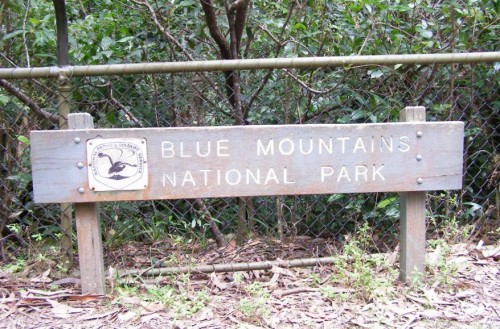
Wildlife Service sets fires to another 3000ha of World Heritage bushland
.
Last Wednesday (18th May 2011) right across the Blue Mountains, thick smoke choked the sky in a eye watering haze. By Friday, an artificial red sunset was blazing through the wood smoke at the end of two days of New South Wales government-sponsored bush arson.
I knew exactly the ecological disaster unfolding, out of sight out of mind.
In its annual misguided winter ritual, the National Parks and Wildlife Service (Wildlife Service), aided and abetted by the Rural Fire Service has deliberately setting fire to remote bushland across The Blue Mountains World Heritage Area – a ‘natural planet asset’ of which the Wildlife Service is international custodian.
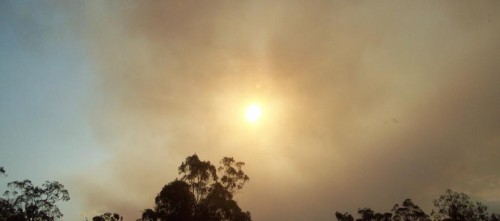
.
Linden Ridge HR Ops (May 2011)
.
On Wednesday afternoon 18th May 2011, the aerial incendiary bombing commenced at Linden Ridge and extended down to the Grose River inside the Blue Mountains National Park (within designated wilderness within the World Heritage Area). Bushfire management euphemistically call it ‘hazard reduction‘ (HR) ; rejecting any notion that bushland habitat is a natural asset, and instead demonising it as a ‘hazard’.
.
Massif Ridge HR Ops (May 2010)
.
The Linden Ridge ‘ops’ follows an almost identical HR ‘ops’ conducted the same time last year on 12 May 2010 in which aerial incendiary ‘ops’ commenced around Massif Ridge some 12 kilometres south of the town of Woodford in wild inaccessible forested area of the World Heritage Area. Some 2500 hectares of high conservation habitat bushland in a protected wilderness area called the ‘Blue Labyrinth’ was indiscriminately incinerated – ridgetops, gullies, everything. Refer to previous article on this website: >’National Parks burning biodiversity‘.
The same Blue Mountains National Park has been targeted by the same aerial incendiary bombing by the same Wildlife Service. Both the operations were carried out under the orders of the Blue Mountains regional manager, Geoff Luscombe.
 This is reducing the ‘hazard’
Click photo to enlarge, then click again to enlarge again and look for anything living.
After a year look for the animals.
After two years look for the animals…. This is reducing the ‘hazard’
Click photo to enlarge, then click again to enlarge again and look for anything living.
After a year look for the animals.
After two years look for the animals….
.
.
.
Gross Valley Defacto HR Ops (Nov 2006)
.
Both the above HR Ops follow the massive conflagration of November 2006, infamously recalled across the Blue Mountains community as ‘The Grose Fire‘. Two abandoned lightning strikes coupled with HR Ops along the Hartley Vale Road and escaping backburns coalesced and incinerated an estimated 14,070 hectares of the Grose Valley and adjoining ridge lands, much of which is designated wilderness. Many consider the actions of the bushfire management response in hindsight to have been a defacto hazard reduction burn. With such an effective elimination of the natural ‘hazard’ that year, as well as the public outrage, HR Ops went quite for four years.

How many animals native to this beautiful Grose Valley suffered an horrific burning death?
How many of their kind have now perished forever from the Grose?
…ask your Wildlife Service at Blackheath!
Charles Darwin in 1836 counted platypus in the area.
.
The perverted rationalisation by bushfire lighting theorists who have infiltrated the Wildlife Service is that the natural bushland, forests and swamps of the Blue Mountains World Heritage Area are perceived not as a valuable natural asset, but as a world ‘hazard’ area to be feared and ‘to be burned in case they burn‘.
These same bushfire lighting theorists have effectively infiltrated, appeased and silenced local conservation groups such as the otherwise very vocal Blue Mountains Conservation Society, the National Parks Association of New South Wales and the umbrella conservation group the New South Wales Conservation Council.
The local conservation movement’s complicity to sanction explicit broadscale ecological harm is a disgraceful and ignoble abandonment of cherished core values, and a breach of duty to faithful environmental membership.
.
.
.
Broadscale indiscriminate ‘HR’ is no different to wildfire or bush arson
The Linden Ridge and Massif Ridge HR Ops were approved and executed by government in the name of ‘hazard reduction’ – to reduce the available ‘fuel’ (native vegetation) for potential future wildfires or bush arson. In both cases, the massive broadscale natural areas burnt were not careful mosaic low intensity burning around houses. This was broadscale indiscriminate fire bombing of remote natural bushland many miles from human settlement. How can the deliberate setting alight of bushland where no fire exists, where no human settlement requires protection from the risk of wildfire be construed but anything other than ‘government-sanctioned bush-arson‘?
.
The ‘Ecological Burn’ Myth
.
When bushfire management can contrive no other excuse for setting fire to native vegetation, such as when that vegetation is many miles away from human settlement and so poses no direct threat, out comes the concocted theory of the ‘ecological burn’. The ‘ecological burn’ theory starts with the premise that because humans have observed that the Australian bush ‘grows back’ (eventually) after a bushfire, it may be concluded that the Australian bush can tolerate bushfires. This hypothesis relies on evidence that selected species of Australian germinate after smoke and fire and the example of epicormic growth of many Eucalypts after fire.
The first deductive fallacy of this theory is that all the Australian bush is bushfire tolerant. This deduction is then extended by unsupported assumption that since the Australian bush is bushfire-tolerant, bushfire must be an integral natural process to which the Australian bush has become adapted to bushfire. The assumption is then extrapolated to assert that bushfire is indeed beneficial to the Australian bush. The assumption is then stretched even further to conclude that without bushfire the Australian bush will be adversely affected. The ecological burn theory then prescribes that by burning the Australian bush, whether by natural or unnatural means, the biodiversity of the Australian bush will be improved.
The deductive fallacy goes further, to suit the motives of the fire-lighters. The outrageous generalisation is made that all the Australian bush must be burnt at some stage for its own ecological benefit. ‘So go forth and burn it. The bush will grow back. It will do it good.’
.
The perverted irrational logic that Australia’s native vegetation has adapted to recover from fire, is akin to claiming the human body is adapted to recover from injury such as burns. A wound may heal but no-one seeks to be injured in the first place. And not all wounds heal. A third degree burn to more than 50% of a human body is almost a certain death sentence. What percentage of a wild animal’s body can be burnt and the animal still survive? That’s a perverted question for the fire-lighters.
Broadscale hazard reduction is not mosaic patch-work fire. It is not creating a small scale asset protection zone around the immediate boundary of a human settlement. It is wholesale bush arson that is driving local extinctions. Ever wonder why when bushwalking through the Australian bush so few native animals are seen these days? Their natural populations have been decimated through two centuries of human harm – mainly poaching, introduced predation and habitat destruction including by human-caused bushfires and human-abandoned bushfires.

The recent concept of the so-called ‘ecological burn’ is a contrivance, a myth. It is a false cause fallacy. Ecological fire a defunct scientific theory contrived by bushfire management engaging unemployed graduates to think up an idea for a PhD. It belongs in the same discarded bucket of defunct scientific theories from days of yore of such ilk as ‘alchemy‘, ‘phlogiston‘, ‘flat earth‘, ‘hollow earth‘ and ‘the birth cries of atoms’ theories. Yup, these were once believed.
[Source: http://www.shortopedia.com/O/B/Obsolete_scientific_theories].
.
The effect on wildlife habitat by broadscale ‘hazard’ reduction is no different than if it was caused by wildfire or bush arson. The hazard to wildlife habitat is the same. The broadscale blanketing of bushland with high intensity burns that reach into the tree tops and scorching ground cover and earth, present the same intense fire regime. The landscape is laid to waste in just the same way as wildfire or bush arson does. Habitat and the wildlife it accommodates become the innocent victims of horrific bushfire, no matter how caused.
There is no wildlife monitoring before, during or after one of these aerial incendiary ‘ops’. Aerial incendiary guarantees no discretion between fire sensitive habitat and fire-resilient habitat. It is a simplistic, convenient a cheap one-size-fits-all solution that re-colours the fire maps to appease political masters. The chopper boys are given their bombing co-ordinates and then do their search and destroy mission. These airborne lads should apply their skills to good and not evil. They should stick to improving their water bombing skills, not participating in this perverted fire-lighting culture.
When the rains follow, the thin yet vital topsoils get washed away into the gullies and streams. This erodes the landscape and prevents regrowth of many flora species due to the lack of vital nutrients. After both the Massif Ridge HR and the Linden Ridge HR, heavy rains did follow.
Only the species of flora adapted to bushfire recover. Fire sensitive species of flora are eliminated from the landscape. Name one species of fauna that is fire tolerant. Where are the zoologists in the Wildlife Service to tell of the impact of the HR? If this mob is providing a ‘service’, it certainly ain’t providing a service to wildlife.
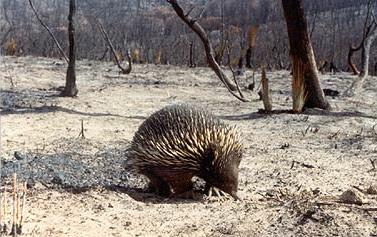
.
.
.
Wildlife Service chief boasts of mass incineration of 92,000 ha of National Parks
.
And the Wildlife Service regional chief for the Blue Mountains region, Geoff Luscombe, in his media release 17th May 2011 boasted of his:
“3000 hectare burn” that “the NPWS carried out more than 92,000 hectares of hazard reduction in 269 burns in 2009/10 – its biggest ever program.”
.
To put this area into perspective, in terms of the Blue Mountains World Heritage Area of about 1 million hectares, such a hazard reduction programme over a decade would decimate the Blue Mountains completely. And they call themselves a ‘Wildlife Service’?
Once again thousands of hectares of pristine flora and fauna habitat in deep inaccessible terrain, miles from houses and human property, has been incinerated from the air using contracted aircraft dropping indiscriminate aerial incendiaries. If only these boys had napalm!
Luscombe confirms in his media release…
“An aircraft will be used to manage the burn as most of the burn will take part in remote areas of the Blue Mountains.”
.
This incineration of natural wildlife habitat is justified by the Wildlife Service as ‘strategic‘ and ‘hazard reduction‘ operations are one of many being conducted by NPWS around the state making the most of the dry sunny winter conditions. This burn is part of the NPWS annual fire management program.
Luscombe again:
…“reducing the volume of fuels within strategic areas of the Park, can assist in limiting the intensity and rate of spread of a wildfire in the area.”
.
Then on Friday 20th May 2011, vertical plumes of smoke were seen rising from Cedar Valley south of the Jamison Valley ~ another one of these secret HR aerial incendiary black ops that the public is not supposed to know about? No notice on either the Blue Mountains Rural Fire Service site or the Wildlife Service site. Out of sight, out of mind.
.
.
.
‘Strategic Fire Management Zones’ – a symptom of a bushphobic cult out of control
.
Under the Blue Mountains Bushfire Management Committee which governs the Blue Mountains region, ‘environmental assets’ are restricted to “threatened species, populations and ecological communities and Ramsar wetlands, locally important species and ecological communities, such as species and ecological communities especially sensitive to fire.”
So how does aerial incendiary discriminate when setting fire to a contiguous 2500 hectares or 3000 hectares of wilderness?
Answer: It doesn’t , it doesn’t seek to, it doesn’t care. The guidelines are only to keep the greenies happy. It’s called ‘greenwashing’.
The Wildlife Service in its official Fire Management Strategy, has relegated 97.7% of the Blue Mountains National Park into either what it calls ‘Strategic Fire Advantage Zones’ or else ‘Heritage Zones. In essence, heritage Zones are valued natural areas that are protected from fire, whereas the Strategic Fire Advantage Zones are expendable. The Wildlife Service proclaims that …due to the ‘relative lack of practical fire control advantages’ (lack of access and resources), Strategic Fire Management Zones are ‘managed’ to protect community assets… to reduce fire intensity… assist in the strategic control… to contain bush fires and to strengthen existing fire control advantages.
All of which simply means is that it is expendable and can and should be burnt in case it burns. Strategic Fire Management Zones ‘are considered priority for ‘treatment‘ – read targeted for broadscale indiscriminate aerial incendiary. So 2500 hectares of wilderness around Massif Ridge copped it last winter and 3000 hectares of wilderness around Linden Ridge copped it this winter. If it’ red on the fire map, burn it!
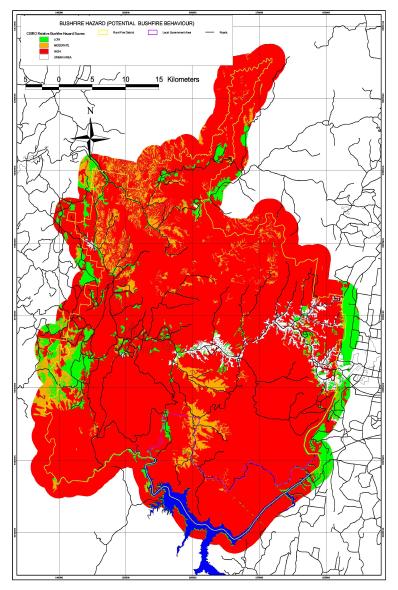
What do these ecological vandals get up to deep in the wilderness at night with their matches and petrol drip torches out of the direct view of the public? They put up signs to deny public access to their nefarious activities. Out of the public view, they are out of sight out of mind.
A cult is a group whose beliefs or practices are considered abnormal or bizarre. Starting large bushfires would seem to fit that definition. Fire-lighting is a cult of ecological deviance, just like any form of arson.
.
.
Precautionary principle ignored
.
“Where there are threats of serious or irreversible environmental damage, lack of full scientific certainty should not be used as a reason for postponing measures to prevent environmental degradation.” [Source: Principle 15 of the Rio Declaration (1992)] Such is the internationally agreed precautionary principle which Australia has adopted as a guiding principle of environmental management. The National Strategy for Ecologically Sustainable Development (1992) adopts the precautionary principle as a “core element” of ESD as does the Inter-Governmental Agreement on the Environment, and the Wildlife Service is supposed to be bound by it in its management of National Parks.
The Wildlife Service once a trusted upholder of the science-based ‘precautionary principle‘ has of late succumbed to the more red neck bushphobic fear of the bush. What the general public hears about the Wildlife Service these days is its broadscale fire bombing of vast areas of vegetation in its ‘protected’ National Parks. This is confirmed these days by the wood smoke-filled air choking many communities and responsible for unknown volumes of smoke emissions contributing to net human-caused pollution to the planet – what many call ‘climate change’.
In the Wildlife Service’s Plan of Management for the Blue Mountains National Park the only reference to the precautionary principle is “Maximum levels of total commercial recreational use in the park will be set for particular activities and particular locations according to precautionary principles.” (p.84) In its Fire Management Strategy for the Blue Mountains, the only reference to the precautionary principle is “the precautionary approach will generally be applied in the absence of specific information.” (p.53)
Clearly the Wildlife Services respect for the precautionary principle is tokenistic, and wholeheartedly disregarded with its use of aerial incendiaries. The Blue Mountains delicate ecosystems are vulnerable to the indiscriminate fire regimes being imposed upon them. The burning into the tree canopy, the broadscale contiguous burning, the scorching of the landscape until bare earth can be seen is highly damaging to the many micro ecosystem across the Blue Mountains. When such burning occurs what happens to the micro-organisms, fungi species and the natural soil biota?
.
” Much hazard reduction is performed to create a false sense of security rather than to reduce fire risks, and the effect on wildlife is virtually unknown.”
~ Michael Clarke (Associate Professor, Department of Zoology, La Trobe University, 2008)
.
.
.
.

A discredited Wildlife Service
.
The once trusted and respected Wildlife Service has lost its conservation way. It now spends more time, money and training on burning fragile ecosystems in its National Parks and exploiting those same parks for tourism exploitation, than it does on wildlife habitat rehabilitation. Sydney’s Taronga Zoo has become far more active and valuable in its urban wildlife recovery programmes than the Wildlife Service is in the wild.
At the carpark above Katoomba Falls within the Blue Mountains National Park, a rather old and deteriorating sign put up by the Wildlife Service years ago, conveys a conservation message to park users. The last two sentences are particularly poignant in light of the massive scale of broadscale bush arson repeatedly being inflicted by the protectorate of the National Park – the Wildlife Service. If only the Wildlife Service would “leave nothing but footprints” and follow its own maxim.
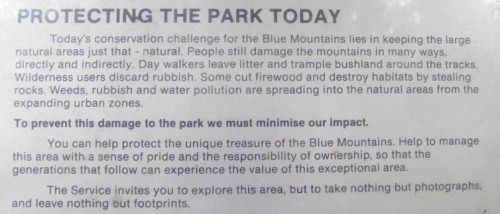
Indiscriminate bush arson of remote bushland in a National Park shows that the Wildlife Service has descended into a predatory wolf in sheep’s clothing. It’s management cannot be trusted with its custodial responsibility to protect the unique treasure of the Blue Mountains.
Once I had a desire to embark on a career as a National Parks Ranger. Had I, in the end, I would have morally wrestled with the hypocritical politics and lasted less than the initial probationary period. I empathise with those who hold a personal commitment to ecology and environmentalism within the Wildlife Service.
.
.
.
The key drivers of the ‘HR Culture’
.
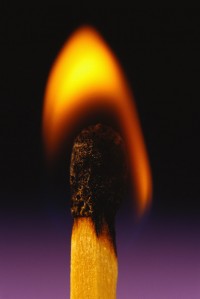
The perverted and unquestioned rush to set fire to as much bushland as possible across the Blue Mountains and indeed across Australia is being driven by five cultural factors:
- ‘Ecological Fire’ Myth. (as described above) Certain ”fire ecologists’ (a self-described term for many seeking to make this a lucrative profession) who are funded by bushfire management agencies, not surprisingly have conjured the academic theory that burning the bush is good for it because it increase biodiversity – just what bushfire management with their cheque book want to hear! They have conjured the term ‘ecological fire‘, which as a euphemism sounds good, so it must be good. So those setting fire to the bush may have no moral qualms. Crap. Show me any native fauna that proliferate after fire – ‘ecological’ or otherwise!
- Under-Resourced. Bushfire management is being repeatedly denied the necessary resources and technologies to quickly detect, respond to and suppress bushfore ignitions as and when they do occur, so there is a mindset of futile frustration that nothing can be done to stop bushfires frequently getting out of control.
- Bushphobic Extremists have become effective in their fear campaign to influence natural land managers, politicians and the media in their one dimensional theory that if bushland is not burnt to remove ‘fuel loads’ catastrophic firestorms will inevitably bring forth Armageddon. They preach that only the wholesale removal of forests will prevent wildfire. (Replacement with concrete would prevent it too.) Their constant evangelising reaches such irrational hysteria, that in order to appease them, HR Ops are promised and executed just to keep them at bay.
- False Sense of Security. ‘Much hazard reduction is performed to create a false sense of security’ (James Woodford, 8-9-2008). But how is burning remote bushland many kilometres from the human interface, allaying human security concerns? Yet hazard reduction is known to directly cause a sharp increase in fuel loads due to an unnaturally high and uniform germination of understory plants.
- Winter Idleness. Fire fighting naturally quietens off during the cooler wetter month of winter, and since Australian bushfire management agencies in the main only do bushfire management rather than throw on an SES jacket, multi-task in complimentary emergency management; many bushfire agencies are perceived (rightly or wrongly) as being idle over winter. So HR gives ’em all something to do!
.
.
.
The Wildlife Service must ‘love the smell of napalm (and smoke) in the morning’
.

The Wildlife Service undertaking these remote HR Ops, sending in the airborne firelighters, must be like watching the Huey helicopter beach attack scene in Francis Coppola’s 1979 film Apocalypse Now, based on Joseph Conrad’s novel ‘A Heart of Darkness’. Colonel Kilgore in his black Confederate cowboy hat shouts:
“We’ll come in low out of the rising sun, then about a mile out we’ll put on the music; scares the hell out of the slopes.”
Richard Wagner’s “Ride of the Valkyries” is played and the boys play war games with real aircraft and real fire and causing real death and destruction.

A giant napalm strike in the nearby jungle dramatically marks the climax of the battle. Kilgore exults to Willard, “I love the smell of napalm in the morning… The smell, you know that gasoline smell… Smells like … victory”, as he recalls a battle in which a hill was bombarded with napalm for over twelve hours.

The Wildlife Service aerial incendiary boys must think of themselves as Special Forces. Perhaps there is a Colonel Kurtz among them – like an insane killer operating deep inside Laos. Kurtz’ final lines in the film are “The horror! The horror!” How comparable with what is happening deep inside Australia’s wilderness areas, out of sight out of mind? …with extreme prejudice!

How comparable is the US secret war fire bombing of Vietnam, Cambodia and Laos during the Vietnam War with the out of sight fire bombing by the Wildlife service of vast areas of Australia’s natural landscape?
The legacy of the Wildlife Services’ aerial incendiary campaigns deep inside National Parks will be one remembered for fire bombing wildlife habitat from once natural and densely vegetated into a one unnatural, sterile and ghostly quiet.
When it is too late, hazard reduction will be acknowledged by our children as naiive threatening process of our generation that drove Australia’s remaining wildlife into extinction.
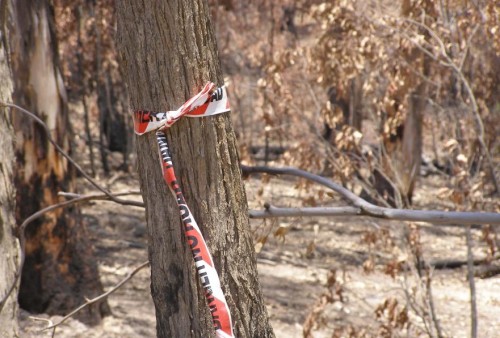
.
.
Further Reading:
[1] ‘ Catering for the needs of fauna in fire management: science or just wishful thinking?’ by Michael F. Clarke, Wildlife Research, Vol. 35 No. 5 Pages 385 – 394, Published 19 August 2008, ‘Ecological fire management in Australia is often built on an assumption that meeting the needs of plant species will automatically meet the needs of animal species. However, the scarcity of..’. ‘Wildlife Research: Ecology, Management and Conservation in Natural and Modified Habitats’, a CSIRO Journal, ISSN: 1035-3712, eISSN: 1448-5494, Available for subscription at http://www.publish.csiro.au/index.cfm
[2] ‘ The dangers of fighting fire with fire‘, by James Woodford, Sydney Morning Herald, 20080908, p.11, http://www.smh.com.au/news/opinion/the-dangers-of-fighting-fire-with-fire/2008/09/07/1220725850216.html (Accessed 20110523).
-end of article –
Tags: aerial incendiaries, applied ecology, blue labyrinth, Blue Mountains National Park, Blue Mountains wildlife, Blue Mountains World Heritage Area, bushfire myth, bushfire tolerant, bushphobic, conservation biology, ecological burn, fire-lighting cult, fuels, government bush-arson, greenwashing, Grose Valley Fires 2006, hazard reduction, heritage zone, koala extinction, leave nothing but footprints, Linden Ridge HR, Massif Ridge HR, NPWS, precautionary principle, prescribed burning, RFS, strategic fire advantage zone, strategic fire management zone, wildfire, Wildlife Service
Posted in Blue Mountains (AU), Threats from Bushfire | No Comments »
Add this post to Del.icio.us - Digg
Wednesday, May 12th, 2010
by Editor 20100512.
Yesterday, The NSW Department of Environment, Climate Change and Water (DECCW) within its Parks and Wildlife Group set fire to over 2500 hectares of remote wilderness in the Greater Blue Mountains World Heritage Area.
This deliberate burning was carried out in the name of ‘hazard reduction’ – in order to reduce the available ‘fuel’ (native vegetation) for potential future wildfires or bush arson.
Under the orders of the Blue Mountains regional manager, Geoff Luscombe, this deliberate burning was started around Massif Ridge some 12 kilometres south of the town of Woodford in wild inaccessible forested area of the World Heritage Area.
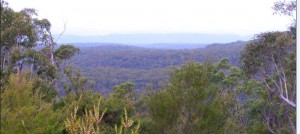
Aerial incendiary from a helicopter was used to ignite the forest vegetation floor and incinerate all ground cover and vegetation habitat across a large contiguous area, crossing over creeks and gullies. Fanned by a light southwesterly, the fire incinerated all native ground cover up to the tree canopy for a distance of 5 km into the Blue Labyrinth up to The Oaks Fire Trail.
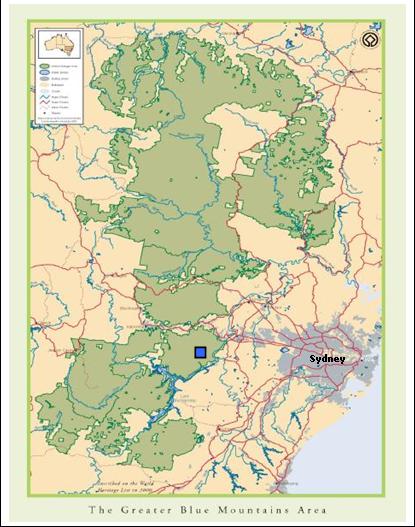
Luscombe told the media that:
“this late warm weather has created a window of opportunity for us to get this important burn done and we’re taking full advantage. “The 2507-hectare burn will be conducted south of the Woodford-Oaks fire trail, and as a result the trail will be closed to mountain bikers and bushwalkers for the duration of the burn – approximately four to five days….“This burn is aimed at reducing fuel loads to help protect properties and assets in the region.” [1]
Luscombe ignores the massive natural asset in the region is indeed the Greater Blue Mountains World Heritage Area he is setting fire to. The scale of the forested area affected equates to a 5km x 5km area, or 25km2 – an area about 1/3 the size of Lake Burragorang. Yet, the official Rural Fire Service website typically and misleadingly shows the burn area size as ‘zero’ hectares.[2]
| Incident Name |
Alert Level |
Location |
Council Area |
Status |
Type |
Size (Ha) |
Agency |
Last Updated |
| Massif Ridge Hazard Reduction |
Advice |
Massif Ridge Hazard Reduction |
Blue Mountains |
Under Control |
Other |
0 |
Dept Environment & Conservation |
|
The scale of the combined burns was also evident from the blanket of smoke smothering the entire Sydney basin and Cumberland Plain yesterday. This is shown in the following photo from the Sydney Morning Herald.
 Smoke Haze over Sydney Smoke Haze over Sydney
© Photo by Sydney Morning Herald
Broadscale Burning Policy
The purpose of bush fire-fighting is to put out bushfires and in the case of wildfires to limit their spread and impact.
However, DECCW’s bush burning policy is advocating exactly the opposite. This year up until 19th April 2010, DECCW boasts that it has performed 193 prescribed burns across NSW ‘treating’ more than 56,000 hectares. Last year it manage 168 prescribed burns ‘treating’ a similar 59,202 hectares. It claims this represents one of the biggest ever deliberate burning programs in National Parks’ history.[3] This equates to an area of national parks being burned every year approximating ¼ the area of the Australian Capital Territory; and this is on top of wildfire and bush arson.
Every year DECCW contracts helicopters and indiscriminately tosses out incendiary devices over wilderness forests. Thousands of hectares are burnt in a free-for-all and thousands of native animals are roasted. Thank crikey these State-sanctioned arsonists aren’t given access to napalm.
DECCW labels its deliberate burning of native vegetation with euphemisms like ‘hazard reduction’, ‘controlled burning’, ‘prescribed burning’, ‘cool burning’ and even ‘ecological burning’. It claims burning vast areas of vegetation somehow ‘assists’ biodiversity, justified on the simplistic premise some species of flora are fire tolerant and grow back. DECCW claims that its burning is essential to manage biodiversity to maintain the reproductive viability of a species or a community of species. DECCW’s ‘eco-logic’ is that since the bush grows back after fire it must be a good impact and therefore good for biodiversity.
DECCW terms areas of national parks targeted for such broadscale burns as ‘Strategic Fire Advantage Zones’ or SFAZs. DECCW justifies charcoaling a massive contiguous landscape as ‘assisting’ biodiversity.
Bollocks!
Luscombe himself has admitted that given the few reliable days a year it is considered safe to burn, DECCW engages in broadscale burning simply a matter of operational convenience.
Mosaic burning is too labour intensive and the typically inaccessible gullied terrain and thick forested vegetation of many national parks makes mosaic burning impracticable and too costly. Be clear; it is all about operational efficiency, not ecological biodiversity.
Last March, DECCW set fire to 2,200 hectares of native habitat in the Blue Mountains in remote wilderness in Kanangra-Boyd National Park near Jenolan Caves.[4] In April 2008, DECCW dropped aerial incendiaries in remote wilderness just to the north along the Krungle Bungle Range.
Like the Rural Fire Service, DECCW is denied serious public resources to detect and suppress wildfires, so it demonises and burns the bush, so destroying the natural asset it is charged to protect and conserve.
DECCW has descended into ecological bastardry, imposing a regime of arson fundamentalism upon nature. This is an unprincipled ‘bush-phobic’ culture.
Broadscale burning is sterilised ecosystems and driving species extinction
The Sydney Morning Herald reported ‘a rogue breeze drove smoke from hazard reduction burning in the Blue Mountains down to street level.’[5] It is more the rogue management of the National Parks Service that misguidedly thinks burning vast swathes of bush at once is good for biodiversity. This demonstrates the wanton disregard for native fauna and flora habitat and disrespect for Aboriginal cultural heritage.
Large contiguous areas of tens of thousands of hectares severely compromising flora and fauna conservation, potentially causing permanent ecological change and loss of species. In the process, DECCW is destroying natural and cultural heritage values of National Parks, causing long-term ecological damage and driving native species extinction.
Collectively, the forested area of the Blue Labyrinth now will lay sterilised of the naturally rich biodiversity of flora and fauna. When the rains come the exposed tops soil will wash away. Watercourses will choke with sediment. The thin fragile soils will change and so change the ability of the soil to replace the complex floristic structure. Only plants that are fire tolerant will recover. Only plants that are hardy to poor soils will recover. There will be less floristic diversity, not more.
Ground-dwelling mammals will have had their burrows, dens, nests, shelters burned and destroyed by the fires. Food sources for spotted-tailed quolls, rufous betongs and wombats will have gone. The undergrowth will have gone leaving a bare open charred landscape. Such a disturbed open landscape benefits feral pedators like cats and foxes and wild dogs. Complex and dense ground vegetation reduces the impacts of predators. But the post-fire regrowth takes many months and creates a simple shrub and herb layer. This allows maximum freedom of movement for cats and foxes, and provides minimum concealment for their prey.[6]
Territorial mammals and raptors do not simply relocate. They remain in their territory and have to compete with these feral predators. Many die. As top order predators like quolls and owls die, this alters the food chain and contributes to local extinctions.
Such broadscale deliberate burning of forest habitat is a threatening process driving Australia’s mammalian extinctions.
Australia has the worst record of mammalian extinctions of any country on Earth, with nearly 50% of its native mammals becoming extinct in the past 200 years.[7]
Australian native fire tolerant fauna (‘pyrophytes’) like most Eucalyptus, Acacia, Proteaceae, Xanthorrhoeaceae and many native ferns and grasses recover quickly after bush fire. However not all species of Eucalypt are fire tolerant (or ‘pyrophobes’) as commonly assumed. Eucalyptus parvula, Eucalyptus saxatilis and Eucalyptus tetrapleura are not fire tolerant. Also, some species of Acacia are not fire tolerant such as Acacia georgensis and Acacia chrysoticha.
Flora diversity varies with soils, aspect, topography and other factors. The Blue Labyrinth is characterised by a labyrinth of ridges and gullies, hence its name. Flora along riparian zones is generally wetter and not as well adapted to fire as ridgeline flora. Yet DECCW’s one-size-fits-all blanket broadscale burning of 2500 hectares up hill and own dale completely disregards the complex biodiversity variations between the gullies and ridgelines. What its blanket burning yesterday has done to the Blue Labyrinth, however, is indeed to have encouraged a consistent simpler form of regrowth vegetation – that is, less biodiversity.
Obviously no animal species is fire tolerant. The Blue Mountains provides habitat to many native mammals including Yellow-bellied Gliders, Koalas, Feathertail Gliders, Eastern Pygmy-possums, Brush-tailed Rock-wallabies, Spotted-tailed Quolls and Antechinus. What happens to these mammals when caught in burn-offs? Where are the native zoological surveys before and after reports for each of these burns?
Native mammals and raptor birds are territorial and do not relocate and typically perish. Broadscale unnatural fire regimes produce unnaturally high biomass, but not true biodiversity.
DECCW’s policy has bad biased biodiversity and fire ecology science to support its simplistic economic approach to bushfire management. DECCW has lost its way as a custodian of protected areas. It is now charged with priorities for exploitative tourism.
Land clearing and frequent broadscale bushfire continue to put many unique species of Australian wildlife at risk. Over the last two hundred years many species of plants and animals have become extinct. DECCW as trusted custodian of NSW’s natural wild areas and in increasing its frequent broadscale burning is possible the greatest contributor to species extinctions across NSW.
Broadscale Burning Justifications Lack Scientific Merit
The DECCW is charged with custodial responsibility for environmental conservation and protection of the national parks and reserves under its control. DECCW is the lead agency responsible for environmental management of the Greater Blue Mountains World Heritage Area (GBMWHA). The GBMWHA Strategic Plan provides management principles and a framework for the integrated management, protection, interpretation and monitoring of the heritage values.
Two key strategic objectives for DECCW management of the GBMWHA is to ‘identify, protect, conserve… the World Heritage values of the GBMWHA’ and to reduce the potential for major impacts to adversely affect the integrity of the GBMWHA. Where there is doubt about the potential impacts of an action on World Heritage values
the ‘precautionary principle’ shall be applied. Under the ‘precautionary principle’:
“where there are threats of serious or irreversible damage, lack of full scientific certainty shall not be used as a reason for postponing cost-effective measures to prevent environmental degradation”.[8]
Aerial incendiary to indiscriminately burn 2500 hectares of remote wilderness is clearly an impact causing serious and likely irreversible damage to important faunal habitat. Such bush fore management practice on a large congruous scale clearly lacks scientific certainty.
In a CSIRO Journal of Wildlife Research, Michael Clarke, associate professor in the Department of Zoology at La Trobe University says it is reasonable for land management agencies to try to limit the negative effects of large fires and to be sure they do not lead to irreversible damage to native wildlife and habitat.
Much hazard reduction is performed to create a false sense of security rather than to reduce fire risks, and the effect on wildlife is virtually unknown. The sooner we acknowledge this the sooner we can get on with the job of working out whether there is anything we can do to manage fires better. We need to know whether hazard reduction can be done without sending our wildlife down a path of firestick extinctions.[9]
Clarke has called for the massive burn-offs to be scrutinised much more closely.
“In this age of global warming, governments and the public need to be engaged in a more sophisticated discussion about the complexities of coping with fire in Australian landscapes.”
He wants ecological data about burns collected as routinely as rainfall data is gathered by the agricultural industry. Without it, hazard reduction burning is flying scientifically blind and poses a dangerous threat to wildlife.
“To attempt to operate without proper data on the effect of bushfires should be as unthinkable as a farmer planting a crop without reference to the rain gauge.”
In the coming decades, native plants and animals will face enough problems – most significantly from human-induced climate chaos – without having to dodge armies of public servants armed with lighters. Guesswork and winter smoke are not enough to protect our towns and assets now, and the risk of bushfires increases with the rise in carbon dioxide.[10]
The incinerating of 2500 hectares of remote bushland in the Blue Labyrinth yesterday was not to protect the houses and properties of Woodford some kilometres away.
Such broadscale deliberate lighting of thousands of congruous hectares of native forest habitat is not protecting houses. This is not clearing dead vegetation around properties. It was fuelled by an unquestioned vandalistic compulsion to burn any bushland that has not been burnt, simply for that reason and that reason alone. The bushfire management call it strategic. But it is a cultural bush-phobia – a fear and lack of respect for the natural landscape. It harks to early Australian colonial mindset that feared the bush to the extent that one had to tame it else invite wildfire Armageddon.
Contempt for Aboriginal Archaeology in the Blue Labyrinth
The Blue Labyrinth is a rugged natural region of forested hills and gullies a few kilometres south of the central Blue Mountains village of Woodford. It is an area of ancient Aboriginal culture. There are caves in the area displaying Aboriginal rock art dating back tens of thousands of years.
In February 2006, DECCW’s Aboriginal Heritage Information Management System (AHIMS) collated an official record of indigenous archaeological sites across the Greater Blue Mountains World Heritage Area. It listed some 850 discrete archaeological sites and 973 features in the GBMWHA, representative of past indigenous activities that remain in the landscape and are essentially the “Aboriginal archaeological record”.
An Assessment of the Aboriginal Cultural Heritage Values of the Greater Blue Mountains World Heritage Area by the Blue Mountains World Heritage Institute (BMWHI) in 2007 highlights the important Aboriginal cultural heritage values of the area. Recent discovery and documentation of numerous Aboriginal archaeological sites and features in the Blue Labyrinth include shelters, shelter walls, rock platforms marked with imagery and grooves. These have largely been preserved because of the rugged and inaccessible terrain. The GBMWA remains highly significant for the many Aboriginal communities associated with it and there is a renewed and re-invigorated interest in the Area’s cultural heritage.”[11]
In December 2006, leading world rock art expert Dr. Jean Clottes to dozens of sites across the GBMWHA and the central coast. Clottes was recently appointed to UNESCO to advise the institution on the creation of a World Heritage Rock Art List.
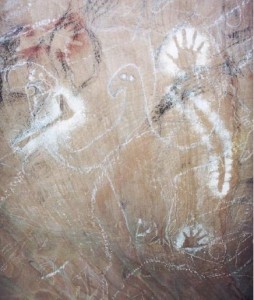
The main eagle depiction at Eagle’s Reach,
acknowledged as extremely rare by the Aboriginal community
© Photo by Paul S.C. Taçon
He was so impressed with the GBMWHA rock art sites, and associated contemporary Gundungurra, Darug, Wiradjuri and Darkinjing stories that he considers the Area to have world Heritage significance. Indeed, it was the living connections to the sites and larger landscapes that most impressed him.[12] Rock Art at Bora Cave in the Blue Labyrinth is an example of important cultural connections of the local Gundungurra and Darug to the area.
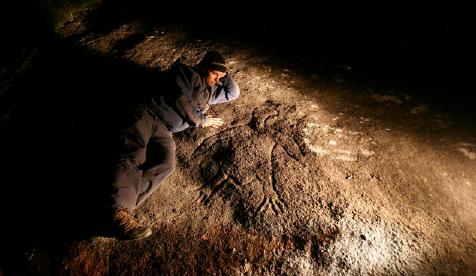
Life-size eagle engraving, Gallery Rock
© Photo by Tristram Miller
Through the Mapping Country research in the Blue Labyrinth area of the Blue Mountains National Park, hundreds of Aboriginal cultural places were recorded. The BMHWI highlighted in its 2007 report the risk of damage by natural environmental processes and exposure to modern human activities. Particularly highlighted was the risk posed by an increase in the frequency and intensity of wildfires and… and efforts to control fires can damage or destroy rock art sites. By locating and mapping sites they can be catered to as part of fire management strategies.[13]
Yet, it would appear from anecdotal evidence that DECCW failed to contact the traditional Aboriginal owners of this land to inform them of the planned burning. It is likely with such indiscriminate broadscale burning that some of the cultural sites may have been irreparable damaged.
What happened to Attic Cave, Dadder Cave and the Aboriginal archaeology between the Massif and The Blue Labyrinth? Was it burnt out and destroyed by DECCW’s needless incineration?
What happened to the wildlife and wildlife habitat? DECCW these days is more a patsy of NSW Labor right wing economic rationalism focusing on tourism revenues, than it is on its core ecological wildlife conservation raison d’etre .
References:
[1] ‘Smokin’: Sydney cloaked by burn-off’, by Paul Tatnell, Sydney Morning Herald, 11th May 2010, http://www.smh.com.au/environment/smokin-sydney-cloaked-by-burnoff-20100511-usg7.html
[2] NSW Rural Fire Service, http://www.rfs.nsw.gov.au/dsp_content.cfm?cat_id=683
[3] DECCW, Nature Conservation > Fire > Managing fire in NSW national parks > Preparation and hazard reduction, http://www.environment.nsw.gov.au/fire/prepandhazreduction.htm
[4] ‘Hazard Reduction – DECC playing with matches in Kanangra-Boyd NP’, 13th March 2009, http://candobetter.org/node/1142
[5] ‘The big smoke finally enjoys a little light relief’, by Ben Cubby, Environment Editor, Sydney Morning Herald, 12th May 2010, page 1, http://www.smh.com.au/environment/the-big-smoke-finally-enjoys-a-little-light-relief-20100511-uuum.html
[6] Chris Johnson, ‘Australia’s Mammal Extinctions: A 50,000 year history’, Cambridge University Press, Melbourne, p.226
[7] Tasmanian Department of Primary Industries, Parks, Water and Environment, http://www.dpiw.tas.gov.au/inter.nsf/WebPages/BHAN-53777B
[8] United Nations, General Assembly, ‘Report of the United Nations Conference on Environment and Development, Rio de Janeiro, 3-14 June 1992, Annex I: ‘Rio Declaration’, http://www.un.org/documents/ga/conf151/aconf15126-1annex1.htm
[9] ‘The dangers of fighting fire with fire’, by James Woodford, 8th September 2008,in Sydney Morning Herald, http://www.smh.com.au/news/opinion/the-dangers-of-fighting-fire-with-fire/2008/09/07/1220725850216.html
[10] ‘The dangers of fighting fire with fire’, by James Woodford, 8th September 2008,in Sydney Morning Herald, http://www.smh.com.au/news/opinion/the-dangers-of-fighting-fire-with-fire/2008/09/07/1220725850216.html
[11] Blue Mountains World Heritage Institute, 2007, ‘Assessment of the Aboriginal Cultural Heritage Values of the Greater Blue Mountains World Heritage Area’, p.10, http://www.bmwhi.org.au/docs/Assessment%20of%20Aboriginal%20Cultural%20Heritage%20Values.pdf
[12] Blue Mountains World Heritage Institute, 2007, ‘Assessment of the Aboriginal Cultural Heritage Values of the Greater Blue Mountains World Heritage Area’, p.10, http://www.bmwhi.org.au/docs/Assessment%20of%20Aboriginal%20Cultural%20Heritage%20Values.pdf p.26
[13] Blue Mountains World Heritage Institute, 2007, ‘Assessment of the Aboriginal Cultural Heritage Values of the Greater Blue Mountains World Heritage Area’, p.10, http://www.bmwhi.org.au/docs/Assessment%20of%20Aboriginal%20Cultural%20Heritage%20Values.pdf p.36
© The Habitat Advocate Public Domain
Tags: aboriginal archaeology, biodiversity, blue labyrinth, Blue Mountains, bush fire, Geoff Luscombe, hazard reduction, mammalian extinctions, massif ridge, prescribed burning, threatening process, Woodford-Oaks fire trail
Posted in Blue Mountains (AU), Threats from Bushfire | No Comments »
Add this post to Del.icio.us - Digg
|
|
























































